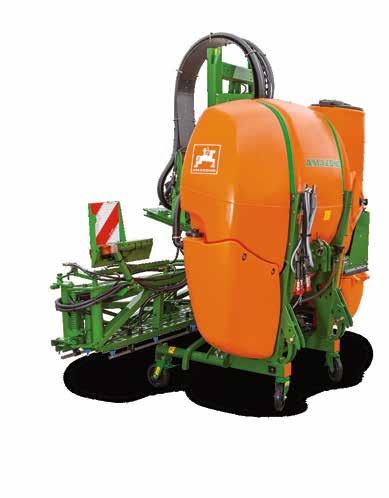& LARGE SCALE FARMER
NEWS Rock around the clock

FEATURE
What’s new in seeders and planters



EQUIPMENT
Pöttinger Tegosem, the tank for flexible application



NEWS Rock around the clock

FEATURE
What’s new in seeders and planters



EQUIPMENT
Pöttinger Tegosem, the tank for flexible application




Accurate and easy seed drill calibration at the touch of your finger - right next to your drill.
No more fumbling through manuals or using the tractor’s in-cab controller. Download our free Duncan Seed Drill app from the Google Play or App Store now for easy and accurate calibration.
The app contains step-by-step guides for making calibration and mechanical adjustments to the drill.

Calibrating a new or existing mechanical drive drill with seed or fert will display the required

Connect wirelessly to a Duncan E-Drive Drill to set up the sowing rates and run the calibrations
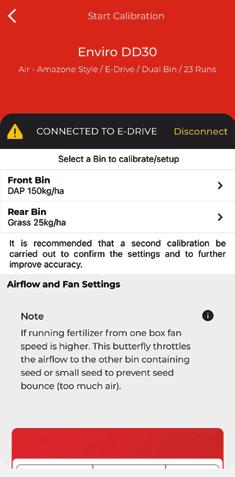


AML, Ashcroft House
Tancreds Road, R D 2, PO Box 37151, Halswell, Christchurch 8245
Ph: +64 3 329 6555
Fax: +64 3 329 6550
www.agrimedia.co.nz
Publishers of Rural Contractor & Large Scale Farmer, AgriBusiness, AgriVet, NZ Cropping, Australian AG Contractor & Large Scale Farmer, NZ Novachem Manual.
EDITOR
Scott Wilson
Mob: +64 21 725 061
Email: scott@agrimedia.co.nz
ADVERTISING SALES
Pulse – Media Sales
Justin Bowler
Ph: 0429 699 553
Email: justin.bowler@mmg.com.au
CIRCULATION
DDI: +64 3 329 6555
Email: admin@agrimedia.co.nz
PRODUCTION, LAYOUT & DESIGN
Mark Winstanley
Email: art@agrimedia.co.nz
Contributors: Delwyn Dickey , Gerhard Uys.
Printed by PrintGraphics Pty Ltd
AC © AUSTRALIAN AG CONTRACTOR AND LARGE
SCALE FARMER - No part of this publication may be reproduced in any form without the prior written permission of the publisher. Opinions expressed in this publication are not necessarily that of the publisher and suggest independent advice be sought before acting on information or suggestions contained herein.
CONTRIBUTIONS - Editorial and photographic contributions are welcomed and should be sent directly to AML. Editing of submissions is at the sole discretion of the editor and will accept no responsibility for unsolicited material.
02 FROM THE EDITOR:
03 Farmer’s labour of love a focal point for Case IH Farmall’s centenary celebrations
04 Rumin8 officially opens demonstration plant as it progresses towards commercialisation
05 Rocking around the Christmas Tree Farm
06 Fordham Agricultural launches new entity
08 Machinery equipment distributor celebrates 30-year milestone
10 Rock around the clock ASSOCIATIONS
12 Fertilizer Australia’s emissions white paper TECHNOLOGY
14 CropScan 4000VT On Combine NIR Grain Analyser
PROFILES
16 Eaglehawk Angus stud
22 Gillian Fennell: The sequin loving bush badass from Outbackistan
26 Across the ditch: Youthful passion turns into busy contracting business FEATURES
32 What’s new in cultivation and tillage
42 What’s new in seeders and planters
EQUIPMENT
54 Kubota’s new RTV-X1130 ready to tackle anything
55 Redekop’s new Seed Control Unit for X9 proven in heavy crop conditions
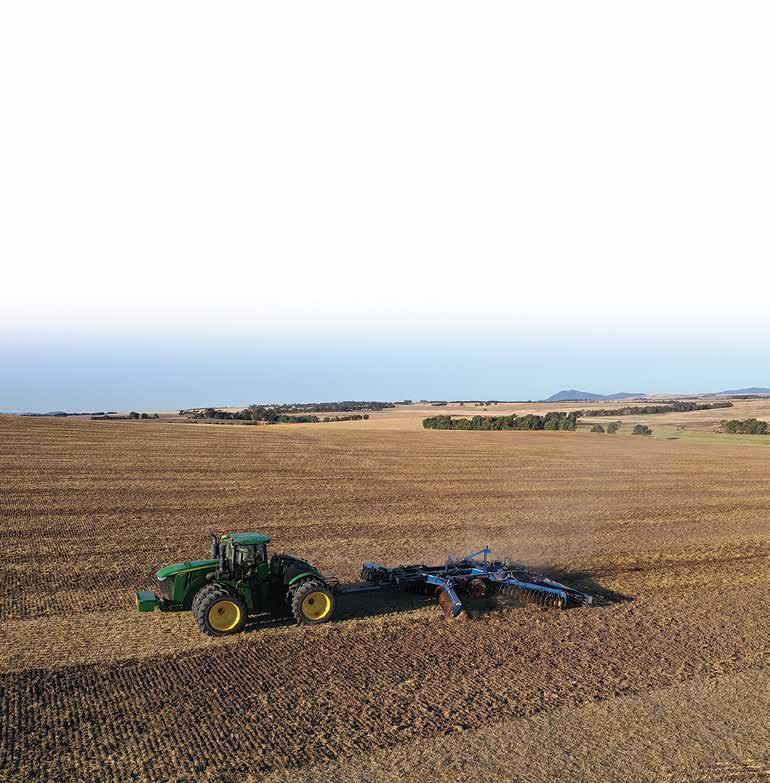
56 New turbo compact tractor gives next level performance
57 Robust seeder bar designed for durability
58 Toowoomba based agricultural machinery dealer and importer B&B Machinery is your forage harvester corn front specialist selling and servicing Kemper products in Australia
60 One for all from Pöttinger: Tegosem, the tank for flexible application

IT’S JUST THE NEWS THE AUSTRALIAN FARMING SECTOR NEEDS AS THE FIRST QUARTER OF 2024 STARTS TO SLIDE BY…PROVIDED THINGS PAN OUT AS EXPECTED
duction, I tripped across a report from ager for RaboResearch Australia and New Zealand, who indicated there are a number of early indications that 2024 should be a

outlook with a cautionary note, reminding

dently into 2024”, indicated there would still be some hangover challenges from the previous year – namely agri commodity
ty surrounding geopolitics in some chal

as 2024 starts to unfold in front of us.






in), farm input prices (fertilisers and chem ical plant protection products) are fore cast to come in below last season’s levels, and shipping costs are below the levels



her husband was nowhere to be seen. She was quite upset because they had a lot to do, so she called him on his mobile phone to ask where he was.



remember the jewellers we went into about

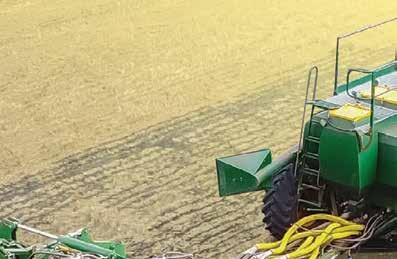




























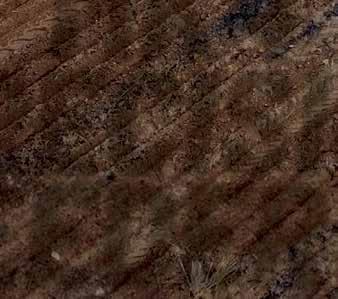
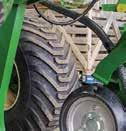




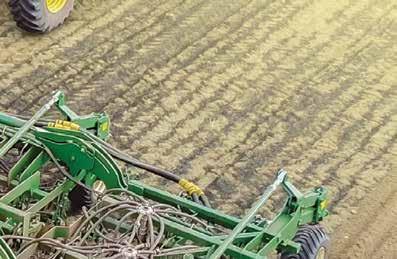




























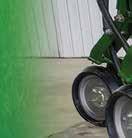


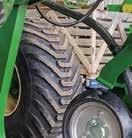




AS 2023 DREW TO A CLOSE, SO TOO DID THE CENTENARY CELEBRATIONS FOR THE CASE IH FARMALL TRACTOR, AND WHAT A YEAR IT WAS.
One of the focal points for the centenary has been a historic 1940s restored Farmall that has been on the field day circuit promoting the unique milestone and providing an insight into the proud history of this important tractor model.
The fully restored 1949 Farmall was purchased by Case IH during 2023 to help showcase the celebrations, and was displayed at the AgQuip, Henty and Yorke Peninsula field days throughout the year.
The tractor was bought from Kerang in Victoria, restored by passionate collector Cedric Sheaf who passed away early this year at the age of 91, and whose family wanted to ensure his tractor collection went to new owners who would appreciate them as much as their father and grandfather.
“Dad was so passionate when it came to restoring the tractors he collected, he was very meticulous and took a lot of pride in doing it right. When he died, the tractors were left to various family members, but without the room to store them properly, we then looked to passing them onto collectors as dedicated as dad was, who would real-

ly appreciate them and the history around them,” said Barbara Lawson, one of Cedric’s daughters.
Scott Jericho, Case IH Tractor Product Specialist, said it was important to the company to invest in its own vintage Farmall tractor to promote the centenary at a variety of events
THE TRACTOR PURCHASED BY CASE IH ON SHOW AT AGQUIP 2023.
CEDRIC SHEAF ON THE FARMALL SUPER A IN A LOCAL PARADE IN KERANG.
through 2023, and when he saw the 1949 Farmall Super A advertised by Cedric’s family, he knew it was the right one.
“The fact the tractor was fully restored was

AUSTRALIAN CLIMATE TECHNOLOGY COMPANY
RUMIN8 HAS OFFICIALLY OPENED ITS MANUFACTURING DEMONSTRATION PLANT, A SIGNIFICANT MILESTONE ON ITS PATHWAY TOWARDS COMMERCIALISATION OF THE COMPANY’S AFFORDABLE FEED AND WATER SUPPLEMENTS THAT REDUCE METHANE EMISSIONS FROM LIVESTOCK.
Located in Perth, Western Australia, and officially opened by Western Australia Agriculture Minister Jackie Jarvis, the demonstration plant has been constructed to provide
DAVID MESSINA (RUMIN8 CO-FOUNDER AND CEO) AND HON. JACKIE JARVIS MLC (MINISTER FOR AGRICULTURE AND FOOD; FORESTRY; SMALL BUSINESS).

very appealing because we wanted to be able to use it immediately, and Cedric had done such a beautiful job with it. It’s such a great example of a classic Farmall and it’s attracted a lot of attention and comments throughout the year,” Scott said.
Cedric Sheaf, and wife Inez, were farmers near Kerang before retiring into the town in the late 1990s.
Barbara said he had a Farmall tractor on the farm for many years, so once retired, he started to collect old Farmalls, all in reasonably

PRELUDE
proof of concept – technical, manufacturing and cost of production – to produce the various formulations of Rumin8’s inaugural product.
“The demonstration plant will help Rumin8 overcome one of the biggest hurdles to commercialisation,” said Rumin8 CEO David Messina.
“We know our product works in terms of reducing methane emission from livestock while retaining or improving productivity. Now we need to refine the production of our formulations in a pharmaceutical manufacturing setting rather than a laboratory setting to demonstrate a range of outputs such as cost, product integrity, QA, etc.
“We have every confidence we can success-
poor condition. For Cedric, it became a labour of love restoring the tractors to their former glory.
The 1949 Farmall Super A purchased by Case IH was bought by Cedric from Trentham Cliffs, Mildura, in June 2001, where it had been sitting in a paddock for 13 years.
His collection ended up totalling six Farmalls, which were kept in a shed in the couple’s backyard, Cedric enjoying showing them off at vintage tractor events and driving them in local parades. The Farmall Super
fully achieve those goals using this demonstration plant.”
The demonstration plant is a precursor to large scale production, including pilot plants and full-scale commercial operations.
Once operating at maximum design capacity, the demonstration plant is expected to produce thousands of doses a day, providing additives to support large-scale trials of Rumin8’s product.
“In addition to our own staff, we have established partnerships with local laboratories (University of Western Australia and Murdoch University) to supplement on-site operations for the testing and validation of product made at the demonstration facility,” David said.
A won a number of ‘Best Restored Tractor’ awards at vintage machinery club days.
“Dad would have been so thrilled to know one of his Farmalls was actually purchased by Case IH to help celebrate the Farmall’s centenary year. When my sister and I knew one of dad’s tractors was going to the company, we were really emotional. It meant such a lot and would have meant a lot to him,” Barbara said.
The Farmall Super A is currently on display to the public at Case IH dealership Larwoods Ag at Kadina, South Australia.
IN AUSTRALIA, THE 1ST OF DECEMBER MARKED A MOMENTOUS TIME OF YEAR.
SCHOOL WAS NEARLY OUT, THE HEAT HAD SET IN AND IT WAS OFFICIALLY TIME TO DUST OFF THE CHRISTMAS DECORATIONS AND PUT UP THE TREE.
But this annual ritual often sparks a long-standing debate. When it comes to Christmas trees, do you opt for real or fake?
For Yeowarra’s Tim McMahon, there’s only one answer.
“One hundred percent, nothing beats the real deal,” exclaims Tim.
Though, he might be slightly biased. Owner of Yeowarra Tree Farm, about an hour out of Geelong, Victoria, Tim works tirelessly to ensure the fresh scent of pine fills homes for the holiday season.
Specialising in wholesale Christmas Trees, the farm’s pruned trees are amongst the best in the country.
Each year Tim and his team harvest thousands of trees which are provided to wholesalers across Australia and their business is continuing to grow.
Tim says purchasing a real Christmas tree is growing in popularity, thanks to advances in farming technology.
“There is a misconception that real trees are hard to maintain and messy, however over the years with genetic selection, the trees have a higher density foliage and higher retention of needles.
“Whereas fake trees are made from artificial material which is non-recyclable and eventually end up in landfill.
“Plus, you can’t beat the smell of a real tree. You just don’t get that with the fake ones.”
That scent is overwhelming on the Yeowarra property. The land was originally purchased by Tim’s grandfather in the mid1970s. The intention was to train horses and run cattle.
When Tim’s parents took over the business in the 1980s, the farm’s very first row of Christmas trees was planted. As the trees grew, so too did a new passion.
"It all started as an experiment. They just sort of went for it,” explains Tim, “and they never looked back.
“I had a fantastic childhood, really idyllic. We all chipped in on the farm; even as a kid I loved the work!”
Today sustainability is a significant focus at Yeowarra Tree Farm. Ninety-nine percent of the trees harvested at the farm are sent to


wholesalers which results in minimal waste.
“We are also finishing our Carbon Neutral Certification for our trees which shows that our products are removing the same amount of carbon dioxide from the atmosphere that the production creates.
“This process will provide feedback on how to make our operations more sustainable.
“It also provides our customers with peace of mind that they are purchasing a product that is not harming the planet. We’re proving that you can have a real tree in your home every year, forever, with zero impact to the planet. That really excites us.
“That’s something you don’t get with plastic Christmas.”
Tim studied engineering when he finished school. He now lives somewhat of a double life, commuting to Melbourne part-time to work as an engineering consultant. The rest of the week and weekends are spent tending to the farm.
“I love the balance it provides, and I’m so lucky I’m able to spend time in both industries. It allows me to combine my two passions and establish efficiencies and innovation on the farm.
“October marks the start of our sprint season,” explains Tim, “That’s when we start preparing for harvest and we have a larger workforce join us.
“Harvest usually starts around November 20. Then it’s all systems go.”
With sustainability goals driving his business, Tim does not shy away from innovating and utilising new technology to aid in the operational activities on his farm.
“Working with a software developer
TIM MCMAHON
ONLY RECENTLY ESTABLISHED, FORDHAM AGRICULTURAL MACHINERY IS ALREADY WORKING HARD TO ESTABLISH ITS PRESENCE IN THE AUSTRALIAN MARKET.
Managing Director, Guy Fordham, has had considerable experience in the farming and agriculture sector, and he aims to bring that knowledge to his new company.
“Our vision is to deliver products and services that will add value to your farming business,” he says. “Our mission is to supply and support innovative agricultural machinery and technology to create opportunities for you to increase efficiencies and gain beneficial outcomes.”
Guy has spent his entire career in agriculture after being raised on a family farm in England. After leaving the farm and progressing into retail distribution, he took the oppor-
tunity to meet new people and experience many sides of the agriculture industry.
“I started with a merchant, gaining knowledge and understanding with grain, seed, chemical and fertilisers, then into retail sales of machinery for major brands, including managing a branch for CLAAS.”
He moved to Australia in early 2003 and held the role of National Sales Manager for CLAAS, working closely with dealers to support and develop distribution before moving back into retail, where he says he enjoys working with farmers and contractors directly.
This allowed him to build relationships and earn trust with both suppliers and customers to create improved outcomes for all parties.
“My plan for this year is to develop my own business whilst continuing the work that has already started with Novag T-ForcePlus seed drills and provide the necessary support,” he says.

company, I helped create our own workforce and operations management software.
“It helps us manage tasks and provides valuable data to help make informed decisions about our operations on the farm.”
Being away from the farm for half of the week, Tim says the bespoke software provides him with visibility to how his workforce is tracking, providing updates on daily, weekly and monthly tasks.
“It also encourages my team by setting daily goals and they can see how well they have performed the next day. It creates a healthy level of competition.”
Tim hopes his program can be adapted to
help other farmers streamline their operations.
“Right now, there are so few programs that help with workforce management in agriculture.
“My intention is to have this program refined enough to be expanded in the next couple of years so other farmers can enjoy the benefits of a more data-driven operation.”
According to Tim, technology and innovation need to be at the forefront of Australian agriculture.
“The future of technology in agriculture is looking bright. On our farm, we are looking to

“I will introduce a new range of equipment encompassing low disturbance soil looseners, strip-till and equipment from Grange Machinery in the UK whilst continuing to explore opportunities with both brands.
“I’m passionate about what farmers and contractors do and will do my best to develop and evolve my business to meet the demands that we are challenged with.
“I will rise to the challenge and remain optimistic about the future. I look forward to working with you, sharing information, and supplying and supporting innovative machinery.”
For more information, go to www.fordhamag.com.au.
mechanise as much as we can, and I think this movement will gather more momentum over the next 10 years.”
To best optimise on-farm practices, Tim needs the most reliable and durable machines on the market. That’s why his family have been choosing Kubota for years.
“We have some old tractors that were purchased second-hand more than 20 years ago. They are still used on the farm to this day.”
Tim currently uses the B3150 for spraying and the M7 tractors for loading trees onto trucks and other daily tasks.
“The last thing I want to worry about is our machinery not working during our harvest season. That would be devastating for the business and bring on major delays to our shipments. Kubota has never failed us.
“Our dealer, Rhys Evans, is very helpful. Always happy to help and accommodate us. It's wonderful working with them.”
According to Tim, another benefit to the Kubota range is its user-friendly experience.
“We have a lot of people working at the farm at different times of the year due to the nature of the business.
“The main reason we chose Kubota is the simplicity of its machines. They are easier to use and teach than some other machinery.”
As the Kubota M7’s tractors roll up and down the rows of pines, preparing them for sale, Tim has one holiday wish.
“As a society, we need to take practical steps towards improving sustainability and reducing our reliance on plastic.
“The best way to do that at Christmas is by choosing to buy a real-Aussie-grown tree.”


ONE OF AUSTRALIA’S MAJOR AGRICULTURAL AND CONSTRUCTION EQUIPMENT DISTRIBUTORS HAS RECENTLY CELEBRATED 30 STRONG YEARS AND IS GEARING UP FOR MORE TO COME.
McIntosh Distribution has been the name behind the rise of a number of popular brands across the industry, including Morris tillage and seeding rigs, Miller sprayers, Weedseeker and Bilberry spot spraying systems, the Harrington Seed Destructor and LiuGong construction equipment.
Cam McIntosh commenced the business and was the early architect of Morris’ growth in the seeding sector. Today it commands a significant market share and is continuing to deliver for Australian growers, the latest being a new 24-metre version of its revered Quantum air drill in time for next season.
It’s a similar story with Miller, which has just launched its Intelligence range of 7000 Series sprayers that break new ground in spraying application and machine data control, offering significant operational and servicing efficiencies for growers.
The spot spraying systems include WeedSeeker 2, which offers some unique advantages to growers for summer spraying, as well as the first commercially-available green-on-green spot spraying technology developed by Bilberry.
Meanwhile, LiuGong equipment, which celebrates its 20th year in Australia in 2024, continues to strike a chord with operators across the country, so much so that, to keep up with demand, McIntosh Distribution had
THE MCINTOSH DISTRIBUTION TEAM PICTURED DURING ITS 30TH CELEBRATORY CONFERENCE IN PERTH.

to hire several bulk carriers to maintain supply.
McIntosh Distribution General Manager Digby Moullin said the company wasn’t about to slow down either.
“We have more product releases in the pipeline as we are always looking at ways to support our dealer network and end customers,” Digby said.
Two key areas that have underpinned the success of McIntosh Distribution and its associated brands have been its core focus on product support through to dealers and grower customers and the local research and development of products to suit Australian conditions.
“We have a dedicated team working on product improvements to suit local requirements, of which many have then been incorporated by the manufacturers into the original designs to improve their performance in the global market,” Digby said.
The product support team based around

CAM MCINTOSH, WHO COMMENCED THE MCINTOSH DISTRIBUTION BUSINESS, PICTURED CONGRATULATING JOHN DUNCAN FOR 25 PLUS YEARS OF SERVICE DURING THE COMPANY’S 30TH CELEBRATIONS.
the country has grown to more than a dozen and is expected to continue to grow.
“We believe it is extremely important to ensure there are key representatives in each State who can assist with ongoing product improvements, as well as being on-hand and facilitating training for dealers and growers.”
The team is also backed by facilities, including parts warehouses in Perth, Adelaide, Sydney and at Tamworth in Northern New South Wales.
Production, parts and administration areas in Perth have continued to expand and further dedicated facilities are planned for this site and through eastern Australia.
The recent 30th celebrations in Perth brought together the 100-strong McIntosh Distribution team from around the country to acknowledge its journey so far and chart the exciting pathway ahead, while it also recognised the contributions of several members who have played key roles throughout its history.
“We have staff here that started with Cam McIntosh 28 years ago, so it was great to be able to acknowledge their tenure in front of the team,” Digby said.
In concert with the business growth, dealer groups for the equipment brands have continued to evolve and Digby said McIntosh Distribution looked forward to strengthening these networks and welcoming more dealers aboard to support grower customers.

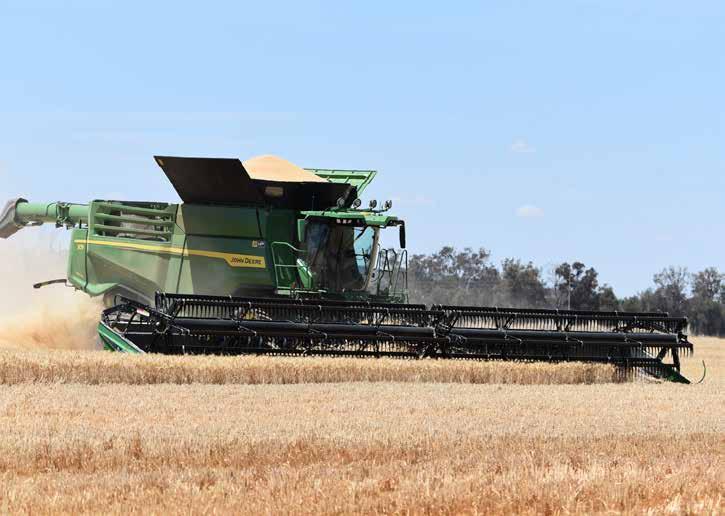





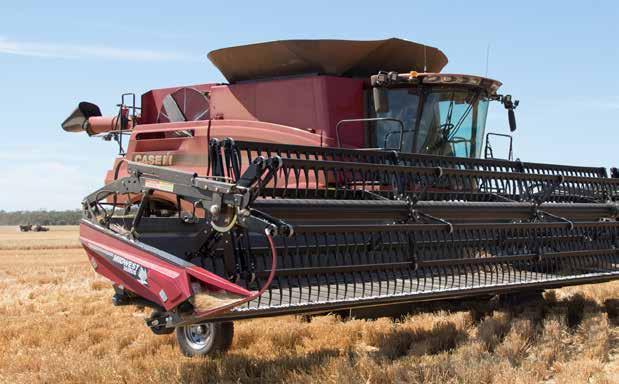



A LARGE-SCALE CROPPING OPERATION IN NORTHERN NSW HAS AMBITIOUS PLANS TO BECOME ONE OF THE FIRST AUSTRALIAN FARMS TO EMPLOY FULLY AUTONOMOUS CROPPING OPERATIONS WITH THE PURCHASE OF A REVOLUTIONARY AGBOT TRACTOR.
Developed by AgXeed, a Dutch technology start-up, AgBot tractors allow a range of monotonous tasks, including tramline renovation, spot spraying, and spreading, to be performed without an onboard operator.
Beefwood Farms, a 12,500-ha aggregation between Goondiwindi and Moree, has taken delivery of its first tractor.
If all goes to plan, the business intends to acquire more tractors.
Beefwood Farms is owned by Gerrit and Pam Kurstjens, together with their daughter, Marieke.
Gerrit had effectively retired after a successful career as an agricultural contractor, transport operator and farm machinery manufacturer in the Netherlands when his passion for gliding brought him to Australia more than 20 years ago.
Soaring high over the black soil plains of northern NSW, he was impressed by the region’s potential and decided to embark on a second career in broadacre farming.
Gerrit and Pam purchased Beefwood in 2006 and began converting the then 2500 ha livestock operation into a continuous cropping, controlled traffic min-till cropping system.
An enthusiastic adopter of technology, particularly those that minimise chemical usage, Gerrit and his team have been utilising optical sprayers for more than 15 years.
“Optical spraying has reduced our chemi-
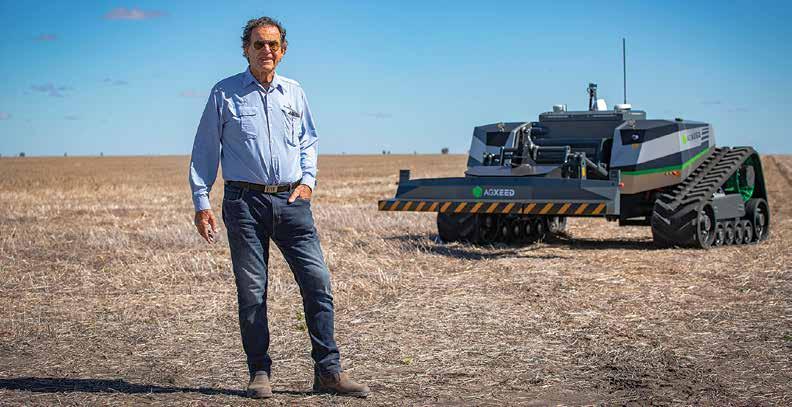
cal usage by 95%, we’re getting better weed control and we’re putting less chemical in our farming system,” farm manager, Glenn Coughran, says.
“The downside is that each sprayer is spending more time in the field, which is why we started looking at autonomous tractors about 10 years ago.
“Gerrit knew some people in Europe who were making self-guided mowing equipment for use on golf courses and for highway maintenance.
“He had to twist their arm to come to Australia to fit this technology to a 350 hp tractor but they agreed to have a go.
“The engineer came over and installed the operating system on our Fendt 936 Vario.
“It took about two weeks to get it going but it worked.”
A John Deere 8345R was converted three years later.
Over the following years, the two tractors clocked up more than 4000 driverless hours spraying more than 40,000 ha and renovating about 25,000 km of tramlines.
Despite this success, Beefwood Farms was
forced to abandon the project after the technology was sold to a farm machinery manufacturer in 2019.
“We were really disappointed – we’d put a lot of time and money into making this work and we were nearly there,” Glenn says.
“We’d got this to being about 95% perfect when we received an email saying the company had been sold and that technical support would no longer be available.
“One of their technicians came out, stripped the gear out, gave us a cheque and that was the end of it.
“We didn’t have the capabilities to do this ourselves so we had to give up.
“It was like losing a couple of our best staff.”
Undeterred, Gerrit contacted some of his former colleagues in the Netherlands who were developing their own autonomous tractor.
After visiting several start-up companies in Europe and the USA, he placed one of the first orders following the commercial release of the AgBot platform last year.
The tracked AgBot 5.115T2 model is powered by a 4.1 L four-cylinder Stage 5 Deutz

diesel engine that produces a maximum output of 155 horsepower and 610 newton-metres of torque.
The engine drives a generator that, in turn, powers the electrically driven tracks, PTO and 700-volt external electric supply.
This hybrid system delivers maximum torque and efficiency at all speeds, without the need for ballast.
“There’s a reason why diesel-electric technology has been used in locomotives for more than 50 years – and that’s because it’s a proven and extremely efficient drivetrain,” Gerrit says.
The eight-tonne unit is equipped with front and rear linkages, high capacity hydraulics, RTK steering guidance and four separate collision avoidance systems.
Two on-board cameras that are connected to the internet via Starlink allow remote monitoring of field operations.
“AgBot really ticks my boxes,” Gerrit says.
“It’s fully autonomous, it’s able to operate 24 hours a day, it’s on a three-metre track width, it’s reasonably economical to run and it’s low maintenance.
“This is a real tractor, it’s just a smaller size.”
The AgBot was immediately put to work renovating tramlines using a six-metre TPOS FlaTrac renovator.
The AgBot has also been successfully paired with a 24 m Croplands Weed-It optical spraying unit.
“So far, we are very happy with the AgBot and we have been pleasantly surprised about
how easy it is to set up and operate,” Gerrit says.
“It is a bit daunting that we’ve got the only unit in Australia but the back-up from AgXeed and Landpower has been great.
“Setting it up for different uses, such as our 48 m Hayes Weed-It optical sprayer, is going to take a bit of work, but it’s something that has to be done.
“We plan to run this unit for as many hours as possible, even doing work that is not necessary, to uncover any problems before we put more units in the field.
“This is just the start and we can’t wait to see what comes next.
“It is expensive but we estimate we’ll halve our hourly operating cost by eliminating the need for a driver and doubling the operating life of the tractor,” Gerrit says.
“We also expect that maintenance and fuel consumption will be much less, as our previous experience with autonomous tractors showed that humans tend to push the machine harder.”
These attributes make AgBot ideal for tedious jobs, such as tramline renovation or round-the-clock spraying.
“Tramline renovation is probably the most boring job on the farm,” Glenn Coughran says.
“We have about 8000 km of tramlines across the six properties and we try to renovate about one third each year, usually following chickpeas when there is less crop residue.


“This year we had three operators renovating tramlines all summer and some of them weren’t too happy about it.
“Being able to do this automatically is not about reducing labour – it’s about being able to use your resources better.
“We’re 55 km from town and we only have four to six full-time employees, so it’s important to get everyone doing what’s more important.”
The ultimate plan is to run a fleet of AgBots performing everything from 24/7 ‘green on green’ optical spraying and spreading fertiliser to shuttling 60-tonne grain bins during harvest.
“AgBot is going to take our spraying program to the next level,” Glenn says.
“Provided conditions are right, we will be able to spray 24 hours a day plus we will be able to cost-effectively apply a second or even a third spray if we have to.
“In time, we plan to retire two of our three self-propelled sprayers and let the AgBots take over.
“We’ll probably end up employing a manager for the day-to-day operations of the AgBots, with other staff going out to refuel and fill the machines each day.”
AgXeed has already caught the eye of several corporate investors, including the German farm machinery manufacturers, CLAAS and AMAZONE, with the former recently appointed international distributor.
AgBot is distributed in Australia and New Zealand by Landpower.


FERTILIZER AUSTRALIA RECENTLY COMMISSIONED A WHITE PAPER TO SUPPORT POLICYMAKERS’ DECISION-MAKING ON POTENTIAL WAYS TO REDUCE GREENHOUSE GAS EMISSIONS FROM NITROGEN FERTILISER WHILE PROTECTING AUSTRALIA’S SOIL HEALTH AND AGRICULTURAL INDUSTRY.
The white paper, Nitrogen Fertiliser Use and Greenhouse Gases – An Australian Assessment, was independently written by Dr Robert Norton, Dr Cameron Gourley and Professor Peter Grace.
Fertilizer Australia Executive Manager Stephen Annells said the white paper provides recommendations that can help the government develop a nuanced and well-considered response to reducing emissions from nitrogen fertilisers while maintaining Australia’s position as a prosperous country that feeds and clothes the world.
“Our recommendations incorporate technological advancements and practice change. None are stand-alone, and combining these recommendations is important to achieving our emissions reduction goal.” Stephen said.
The comprehensive document builds a picture of the challenges and opportunities for government and industry in its quest to reduce greenhouse gas emissions.
Subjects addressed include the importance of nitrogen to food security and public health, understanding and estimating nitrous oxide emissions, efficient and effective use of nitrogen fertilisers on Australian farms and


reducing emissions by improving farming practices.
The authors also explore ways to improve nitrogen use efficiency and reduce emissions through technical advancements like slow-release technologies, greater adoption of precision agriculture tools and incentivising low carbon footprint manufacturing.
Among the document’s key recommendations are:
- Consider policies encouraging the widespread use of nitrification inhibitors and slow-release technologies to improve nitrogen use efficiency and reduce nitrous oxide emissions. Scientific advancement will continue to play a crucial role in reducing nitrogen loss through technologies, but it must be cost-effective for farmers to purchase. They are unlikely to pay more for these products when there is no favourable market or yield outcome from their use. The recommendation suggests it would be more efficient and cost-effective for the government to pay a limited number of fertiliser manufacturers an agreed price per tonne to cover the abatement cost.
- Encourage greater adoption of objective tools like nitrogen budgets and soil and plant testing, which follow Fertcare® stewardship
principles, to guide fertiliser use. Encouraging farmers to determine specific crop nutrient demand from existing soil nutrient availability allows them to determine what type and how much fertiliser product is needed to achieve good soil health and yield. Minimising surplus nitrogen will significantly reduce the potential for offsite nutrient impacts such as nitrous oxide emissions.

- Encourage greater adoption of precision agriculture tools that deliver spatially and temporally targeted inputs where and when most needed. Optimising nitrogen application to minimise nitrogen surplus at a sub-paddock scale (i.e., different application rates within a paddock) will help optimise farmers’ financial return on nutrient inputs and reduce the potential for offsite impacts. Variable-rate fertiliser application technologies have been available for some time, though adoption is generally low. However, the ability to gather and interpret agronomic and economic data and spatially apply varying rates of inputs, such as fertiliser, is challenging for many growers. Others with specialist skills are often needed to implement precision agriculture pragmatically. Policies that make precision agriculture knowledge and skills more widely available and demonstrate the benefits to growers should be considered.
- Incentivise the Australian manufacture of nitrogen fertilisers with a low carbon footprint and nitrogen inhibitors. The production of ‘green’ ammonia, as a feedstock to nitrogen fertiliser manufacture, is an evolving technology. Using renewable energy sources in manufacturing can reduce nitrogen fertilisers’ Scope 3 carbon cost. Nitrogen inhibitors and their ingredients are largely imported, which may lead to supply chain insecurity. Policy settings that support the local manufacture of inhibitors to secure the supply of existing and emerging inhibitors
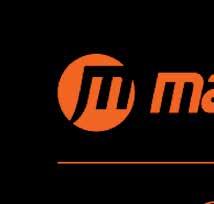

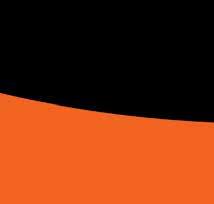
under development in Australia should be considered.
- Encourage industry bodies, research organisations and state and federal governments to share data on fertiliser use, farm management practices and nitrous oxide emissions. The research effort in developing nitrogen best management practices will need to continue as farming systems evolve and new technologies are available. The various commodity research and development corporations and the fertiliser industry hold high-quality data on fertiliser use and management practices. The ongoing high-quality research undertaken across industries provides more complete estimates of nitrous oxide emissions, which will affect the Australia Greenhouse Gas inventory. There is an opportunity for more active data sharing among these groups on nitrogen use and nitrous oxide emissions. This will better quantify nitrogen budgets and nitrogen use efficiencies across applications and scales.
Commenting on the white paper, Professor Richard Eckard, who is a professor of sustainable agriculture at the University of Melbourne and Director of the Primary Industries Climate Challenges Centre, said the document provides a practical overview of the nitrogen cycle, the implications for food security, and the principal loss pathways including greenhouse gases and nitrogen use efficiency.
“I would encourage governments and other people interested in this topic to read this







white paper and consider the recommendations as we move toward lowering GHG emissions,” Richard said.
Read the executive summary and the full White Paper: https://fertilizer.org.au/ news-events-and-publications/fertilizer-australia-white-paper.





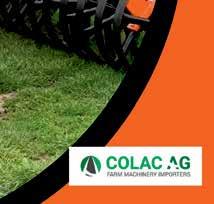
AT AGRITECHNICA IN HANNOVER, GERMANY LAST NOVEMBER, CROPSCANAG RELEASED THE CROPSCAN 4000VT ON COMBINE NIR GRAIN ANALYSER.
The CropScan 4000VT is the first fully integrated version of the CropScan analysers. The system is ISOBUS compatible with the latest Case IH and New Holland brand of combines. The CropScan 4000VT runs a Virtual Terminal within the CNHi Pro 700 and Intelliview IV combine monitors.
Based on 10 years of development through the CropScan 3000H and 3300H 0n combine analysers, the CropScan 4000VT includes a remote sample head that is fitted to the clean grain elevator of the combine, a fiber optic cable, communications cable and a waterproof and dustproof NIR spectrometer that is mounted on the wall of the combine outside the cabin. The NIR spectrometer includes an ECU (Electronic Control Unit) that runs the CropScan software and reads the combine’s CANBUS messages. The CAN messages for Yield, GPS, Crop Type, Grower-Farm-Field, Rotor Engage and
more are read by the CropScan ECU to control operation and data collection.
The CropScan is fully integrated into the CNHi Pro 700 and Intelliview IV monitors using a purpose designed VT screen for the CropScan 4000VT. Once the ignition is turned ON, the CropScan 4000VT screen is available on the Pro 700 and Intelliview IV monitors. The operator simply selects the Crop Type and Grower-Farm-Field menus.
Once the rotor is engaged by the operator, the CropScan begins to analyse the grain as it is collected in the remote sample Head. The protein, moisture, oil, starch and fibre (depending on the crop type selected) are calculated and combined with the Yield and GPS data from the CANBUS messages and then sent to the VT screen. Results are displayed on the VT screen every 3-4 seconds.
The field data is stored in the CropScan ECU and then sent

to the CropScanAg Cloud server, where farmers can access grain logistics, field maps and advanced analytics and performance maps using the N-GAUGE Apps on their mobile phone or tablet.
The CropScan 4000VT sample head has been designed to increase the sample cycle rate from small to large seeds including high moisture corn/maize and beans. The new design flow through cell allows the grains to flow faster through the chamber thus increasing the scan speed. The faster the flow, the higher the field map spatial density for protein, moisture, oil, starch, fiber and yield data. The CropScan 4000VT maps the data approximately every 4-6 meters. The new NIR spectrometer has been ruggedized with a new enclosure
for outside mounting and new operating platform running on a Linux OS to the in-cab app for Apple and Android OS.
The CropScan 4000VT has been bundled to include the N-GAUGE Harvest Manager app and SIM card subscription for five years streamlining all the data connectivity. Together the CropScan and N-GAUGE offers CASE IH and New Holland combine owners with a complete solution for measuring the quality (protein, oil and starch) and the quantity (yield and tank weight) in a seamless and fully integrated system.
For more information on the CropScan 4000VT and N-GAUGE apps, visit the CropScanAg web site www.cropscanag.com or contact CropScanAg at sales@ cropscanag.com.




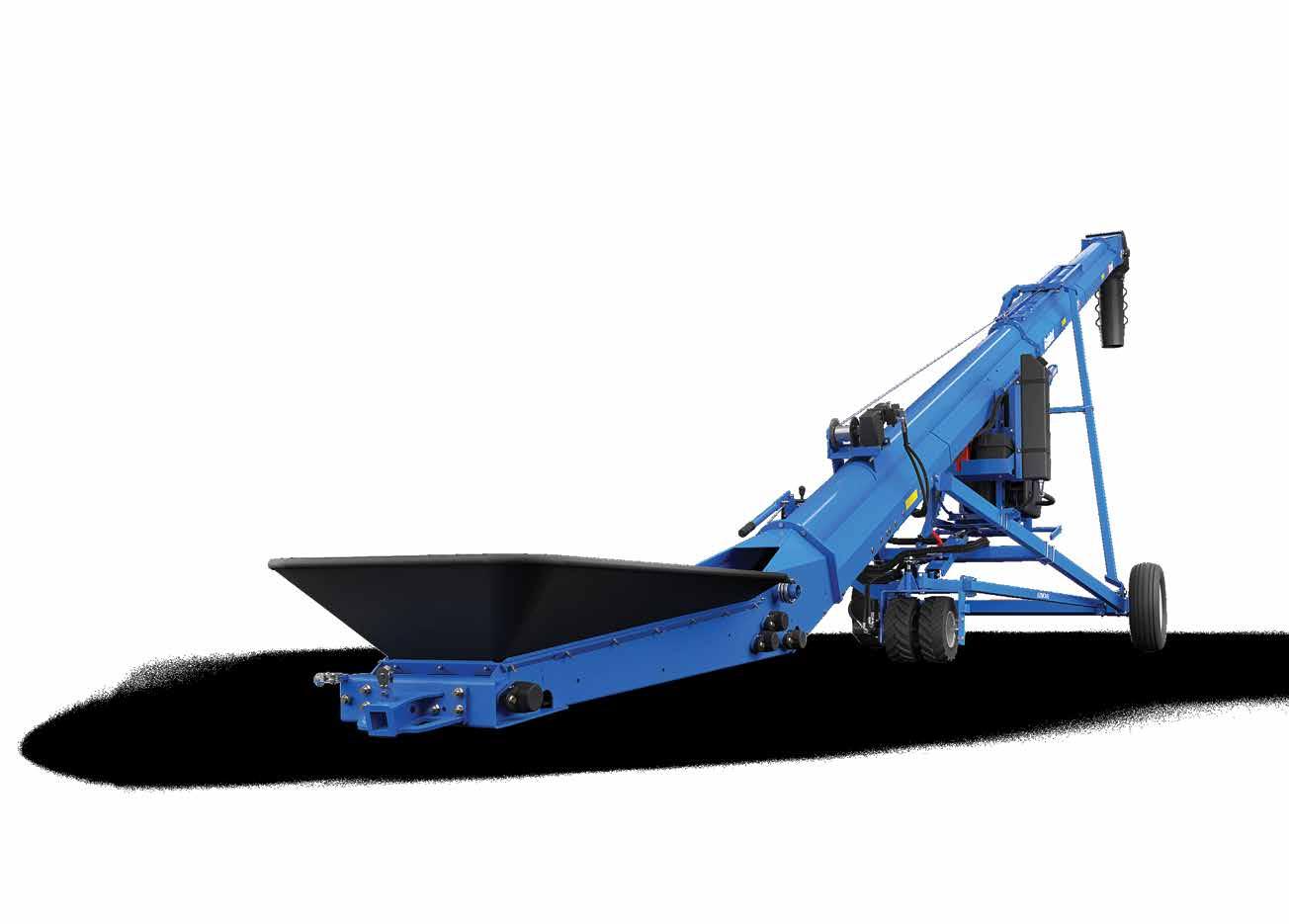
Brandt field grain belts give you the edge you need, delivering high-volume performance with a powerful combination of speed, gentleness, and versatility.
The optimised intake and transition increases grain-flow efficiency to achieve peak performance in varying conditions, moving up to 12,000 bu/hr.
The double-lip intake seal keeps your crop on the belt where it belongs, increasing product retention while loading.
Brandt’s EZTRAK tensioning and tracking system keeps your belt aligned and properly tensioned.

Ian Vivers, who with wife Sally founded the Angus stud in the 1990s, says there are now three generations of the Vivers family on the farm, with their children and their spouses having joined them on their journey.
The farm has a long history.
Ian is a sixth generation farmer, with generations seven and eight already on the farm. A Vivers in one form or the other had continuous ownership of the farm since 1832, Ian says.
The farm was always a sheep and beef operation, with corn grown in the 1950s. Ian says his father John bred Hereford cattle, with Ian and Sally taking over in the 1990s.
As a result of succession in the early 1990s, Sally and Ian started with 1300 acres,
FROM LEFT: IAN’S SON HARRY, NEPHEW WILL, IAN, DAUGHTER ANNIE AND GRAND DAUGHTER THEA. IAN SAYS HE KEEPS THE FARM TOGETHER AND THE FAMILY ON THE FARM.
100 cows and 1000 ewes, and “some debt,” he says.
Today the Vivers family run their Angus stud across three farms.
The main farm, Eaglehawk, is west of Glen Innes, at an altitude between 950 meters and 1150 meters, on what is called the tablelands on the Great Dividing Range, Ian says.
EAGLEHAWK MARKETS APPROXIMATELY 250 BULLS EACH YEAR WITH A COMBINATION OF AN ON-FARM AUCTION SALE AND PRIVATE TREATY SALES.
The farm is approximately 4500 acres. It receives about 32 inches (800 millimeters) of rain annually, with moderate temperatures up to 37 degrees and lows that can dip to -8 degrees .

ALWAYS IN GOOD ORDER, AND BRINGS YOU A THICK EASY GOING CALF TO YARDS AT WEANING TIME.
“We rely mainly on temperate grasses, perennials, like phalaris, fescue, rye, clovers, and some chicory. We’re fortunate that we’re at the right altitude and rainfall to be able to grow such feed. We also do some fodder cropping,” Ian says.
The other farms have different climates. Two hours away, east of Armidale near Ebor, a second farm, Maiden Creek, was purchased in 2018. The farm is at about the same altitude as the Glen Innes land, but its weather patterns are influenced by climate coming from the east, it has higher rainfall and different soil types.
The third farm, Rivendell, is only a 20-minute drive West of the main farm. But it is 300m lower in altitude and has a longer growing season, he says.
It is 3200 acres, of which 2000 acres are developed for fodder cropping.
The main stud is run from the Eaglehawk farm and is also where sale bulls are finished. This farm is also the base for embryo collection.
Maiden Creek, east of Armidale, is an autumn calving cow calf operation and is used as a recipient farm, Ian says.

“It’s our lowest cost of production farm. It runs cows at low input.
“The third farm is a cropping farm and allows us to put young cattle on oat crops and a mix of winter and summer active pastures. It’s got a longer growing season and is better at wintering”.
Ian’s son, Harry, is the farm manager on the Armidale farm, Maiden Creek.
Daughter Annie’s husband, Jeremy, is the operations manager of both Eaglehawk and Rivendell, with Annie not only involved in the day-to-day business, but also leading the artificial breeding business and doing the administration of the farm and cattle records.
Daughter, Maggie, married a farmer, Ed Cordingley, and they farm on his family’s sheep and beef operation.
But she is a graphic designer and manages all Eaglehawk’s catalogue work.
“Sally and myself, we kind of fill in the gaps and we’re there to

be where we need to be to make things work.”
In 1994, Ian and Sally set up an artificial breeding contract business called Power Breeders to help make ends meet.
Through consultancy work attached to that business, Ian met a group of investors who needed help extricating themselves out of a bad investment position in Angus cattle.
He and Sally partnered with the
FROM LEFT: DAUGHTERS MAGGIE AND ANNIE AND SALLY.
group, Pacific Syndicated Beef.
As per the business goals, the syndicate exercised the 10-year exit plan leaving Ian and Sally independent owners of Eaglehawk Angus in 2006.
Ian says during those 10 years they reinvested their profits and income back into their own cows

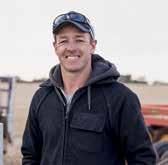


IAN SAYS WHEN THE FAMILY DECIDED TO USE GENETICS FROM THE USA THEY DECIDED THEY NEEDED TO SEE THE HERDS THEY BUY GENETICS FROM WARTS AND ALL. NOW THEY VISIT THE US EVERY TWO YEARS AND DRIVE THOUSANDS OF KILOMETRES BETWEEN FARMS TO CAST AN EYE ON THE HERDS.
and building the Eaglehawk brand name.
Consequently the Eaglehawk Angus brand was able to continue and grow.
They now run around 700 registered cows and 500 commercial cows as well as followers.
In total, around 3000 head are on the three farms at any one time.
Eaglehawk markets approximately 250 bulls each year with a combination of an on-farm auction sale and private treaty sales.
Cows are blanket inseminated each year, with an average take rate of around 60%.
Their best bulls are kept back and go into their sire battery every year.
These bulls “pick up the 40%” of the cows that did not take to insemination, he says.
“The commercial cows and the bottom end of the stud herd have embryos put in. There’s an about 78% take rate on those.”
On Maiden Creek, there are 200 autumn calving stud cows and 500 dedicated recipient cows.
With embryos collected all year, programming and five lots of 100 cows in an embryo program, Ian says Novembers on the farms are manic.
Luckily for Ian, his youngest daughter, Annie, began working as an embryologist right after finishing high school, and continued the work through university, and now continues the work on the farm.
Ian is already an old hand and

unproven bulls into Australia,” Ian says.
“We then made a business decision that if we’re going to use American genetics, we’d need to do our due diligence in the US. It more than paid for itself,” he says.
has been working in the embryo field since 1994.
Ian says the stud took a number of years to find the right genetics that fit their long-term goals.
“Australia didn’t have what we were looking for. In the initial stages we trusted the catalogues. We were using imported sires from the US, but at that stage the Americans sold a lot of
The US Angus herd is 10 times bigger than the Australian herd and Ian says they wanted to take a different genetic approach to what Australian breeders were taking.
Now the Vivers family undertake a 11,000km trip through the US every second year and not only buy bulls that stay in the US but look at the herds “warts and all” before investing in genetics.
In the early 2000s, the Vivers

also established their own beef product, and Ian says this had an influence on what animals they chose for genetics.
“Over that period, and continuing today, there was a large industry push to look at marbling genetics and high performance growth genetics,” he says.
“There’s nothing like running cows through to the point of having a knife in your hand to work out which cattle are the best eating quality, and overall best performers from start to finish.
“We found that cattle that had the highest marbling and growth EBVs took the most resources and were not necessarily the best eating quality,” he says.
As a result, Ian shifted focus to a “maternal on-farm performance animal that’s always in good order, and brings you a thick easy going calf to yards at weaning time. Not only that, they were producing a superior product at a lower cost of production.
“We’ve achieved that by visiting herds and considering more than just breed values. EBV’s are secondary to the main goal of building a cow herd that can handle all conditions,” he says.
The cow of the future, says Ian, is one that has a big rumen that can process lower quality feeds and still extract the protein and the energy they need to create meat, milk and get in calf.
“I think there’s a hype over growth performance in feedlots. They’ve created an animal which
ANNIE GETS STUCK IN!
thrives on a high protein and high energy, small quantity diet which has to be fed by hand.
“When we started our beef product, a long fed Angus was fed for 150 days. Animals are now fed 250 days to extract the most marbling. If farmers are being attacked as environmental vandals, which is completely untrue, we should be reducing days on feed. We are working with two feedlots and have managed to get our cattle down to 180 days feeding, and falling,” he says.
Also, not all farms in Australia can afford to run animals that require high energy and protein as, for example, many areas of Queensland, coastal areas and semi arid areas of western NSW, Queensland and the Northern Territory have poorer quality feed.
“Anything we do to breed an animal that doesn’t require much maintenance, especially not cash out maintenance such as hay etc, does the industry a favour,” he says.
Cattle at Eaglehawk are grazed in mobs of 80 to 100 cows, in eight paddock cells of 400 acres each (approx. 50 acres per pad

dock) and rotated when visual assessment shows they need to move on.
“If we run into a drought we do some forage cropping and put corn silage away, we sacrifice paddocks for that. But that is plan B. Cows only visit each paddock once in winter.”
While marbling seems to have a big influence in the industry, Ian says there should not be too narrow a focus on ultrasound scanning for marbling.
Eaglehawk cattle are bred with very secondary focus on mar
AS A RESULT OF SUCCESSION IN THE EARLY 1990S SALLY AND IAN STARTED WITH 1300 ACRES, 100 COWS AND 1000 EWES, AND “SOME DEBT”, BUT THEY NOW RUN AROUND 700 REGISTERED COWS AND 500 COMMERCIAL COWS AS WELL AS FOLLOWERS. IN TOTAL AROUND 3000 HEAD ARE ON THE THREE FARMS AT ANY ONE TIME.
bling and have average scan results for IMF and yet they have taken blue ribbons at major paddock to plate competitions for meat quality.
However, when Ian ran an on-farm trial to test the difference in marbling scores on animals tested at 400 and 600 days, they found that an animal scoring
high on day 400 might not score as good on day 600.
“And yet it is okay to lodge figures at the society at either 400 or 600 days of age.”
Ian questions the accuracy of the final figures as a result of this anomaly.
“We do our scanning when it suits us from a management







TO HEDGE AGAINST CLIMATE UNCERTAINTY IAN SAYS THEIR STUD COWS NEED TO BE INSURED IN SOME WAY, ESPECIALLY DURING DROUGHT TIMES. “PUTTING HAY IN THE SHED AND SILAGE IN PITS IS AN INSURANCE POLICY. BECAUSE SELLING THEM IS NOT AN OPTION FOR US.”
point of view, instead of trying to scan when we will get the best scores,” he says.
“A heap of things can change in two hundred days, like, for example, hormones. Some animals grow earlier and/or have higher testosterone.”
In the same vein, cattle running in country with fourteen inch rainfall at 45 degrees will perform differently than cattle of the same age run under a centre pivot in an area that’s 26 degrees, he says.
The only sure fire way is to breed the cattle and get feed-
back from the feedlots after processing, he says.
Ian says climate is their biggest challenge on the farm.
“We have very poor intel from the climate experts. There are so many different apps and websites and they all contradict each other. It’s almost impossible to plan more than a few weeks ahead,” he says. “In 2023 the Bureau of Meteorology forecast another El Nino event predicting another major drought. So soon after the 2018/2019 drought it

caused a panic sell off of cattle and a market crash. The El Nino and drought didn’t eventuate, but it was too late. It was a disaster that didn’t need to happen and no one was held accountable,” Ian said.
To hedge against climate uncertainty Ian says their stud cows need to be insured in some way, especially during drought times.
“Putting hay in the shed and silage in pits is an insurance policy. Because selling them is not an option for us.”
The 2018 drought was especially tough as the Vivers had just bought a new farm, and made the conscious decision to keep all their breeding stock.
“We trimmed up all the edges. Because we run a registered stud operation we couldn’t sell the house. That’s our bricks and mortar, that’s our business. We chose to feed at great expense. It ended up being the right decision. We still had all our assets after the drought and they went up in value, much more than the cost of feeding.”
Ian says young farmers who do not have land in their family will find it almost impossible to buy land, as prices are high and banks won’t loan to anyone who doesn’t have a history.
With that in mind succession planning is critical.
“Succession has become an industry that’s created a whole
heap of pizzas. You only get a little slice of a farm. The succession industry wants to split it all up. We’ve made a conscious family decision to keep our farm as one unit. That’s how we can win.”
Keeping the farms in one piece makes long term financial sense, because a property as a whole has more value than a divided one and allows more leverage at the bank and more scale to create income, he says.
Ian says the role women play is critical in a family, as women “keep everything on track”.
Communication is also key in families, he says.
“The family has to be able to communicate on all levels and across all ages and sex.”
To that end the Vivers family all sit down with a coach once a quarter to work on their goals.
Besides quarterly meetings with a coach, the family also sits down every Monday for an operations meeting and, when necessary, addresses family and work challenges and works through them.
Ian says by continuing to grow and by continuing to keep everyone communicating and staying together with a common goal, he envisions the family staying on the farm for another 100 years.
ANNIE IS INVOLVED IN THE DAY-TO-DAY, BUT ALSO LEADS THE ARTIFICIAL BREEDING BUSINESS.
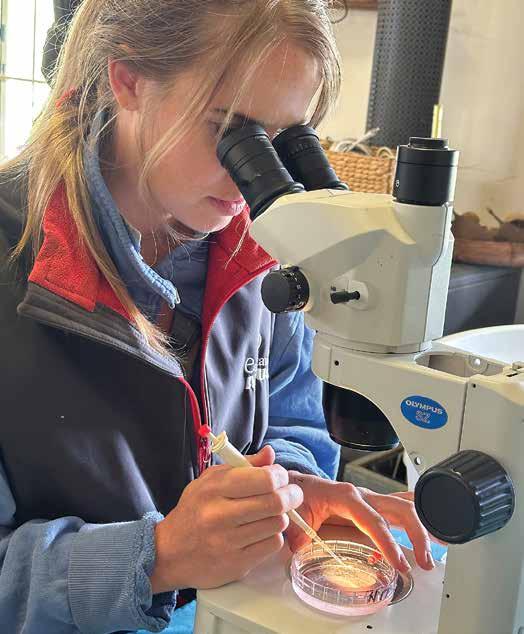



The Discordon is the combinded tool for stubble cultivation, decompacting and consolidation in a single pass. The Voyager Plough offers high performance and precise ploughing in all soil types with exclusive hardened mouldbourd technology for superior strength and durability.




The Tine Seeder is suited to a variety of soils and stubble conditions whilst still ensuring precise and accurate seeding. The AirCart is available in tow-behind and tow-between models in capacities up to 22,000L.


The Highline rock picker tine is designed to follow the reel. This aids in raising rocks whilst allowing dirt to fall through. The tines are also extremely durable as they are hard surfaced on both the top and bottom leading edges.



The Haulmaster Chaser Bin has exclusive features and technology aimed at maximising unloading efficiency and increasing productivity whilst being extremely simple to operate.



Spread a wide range of materials including fertiliser, lime, and gypsum and take your spreading program to the next level! With exclusive design features and technology for precise application of product whilst being extremely durable and simple to operate.

The TruFlex headers are designed to be lightweight but sturdy. Hydraulically controlled depth wheels allow for optimum ground hugging for harvesting in almost any terrain.


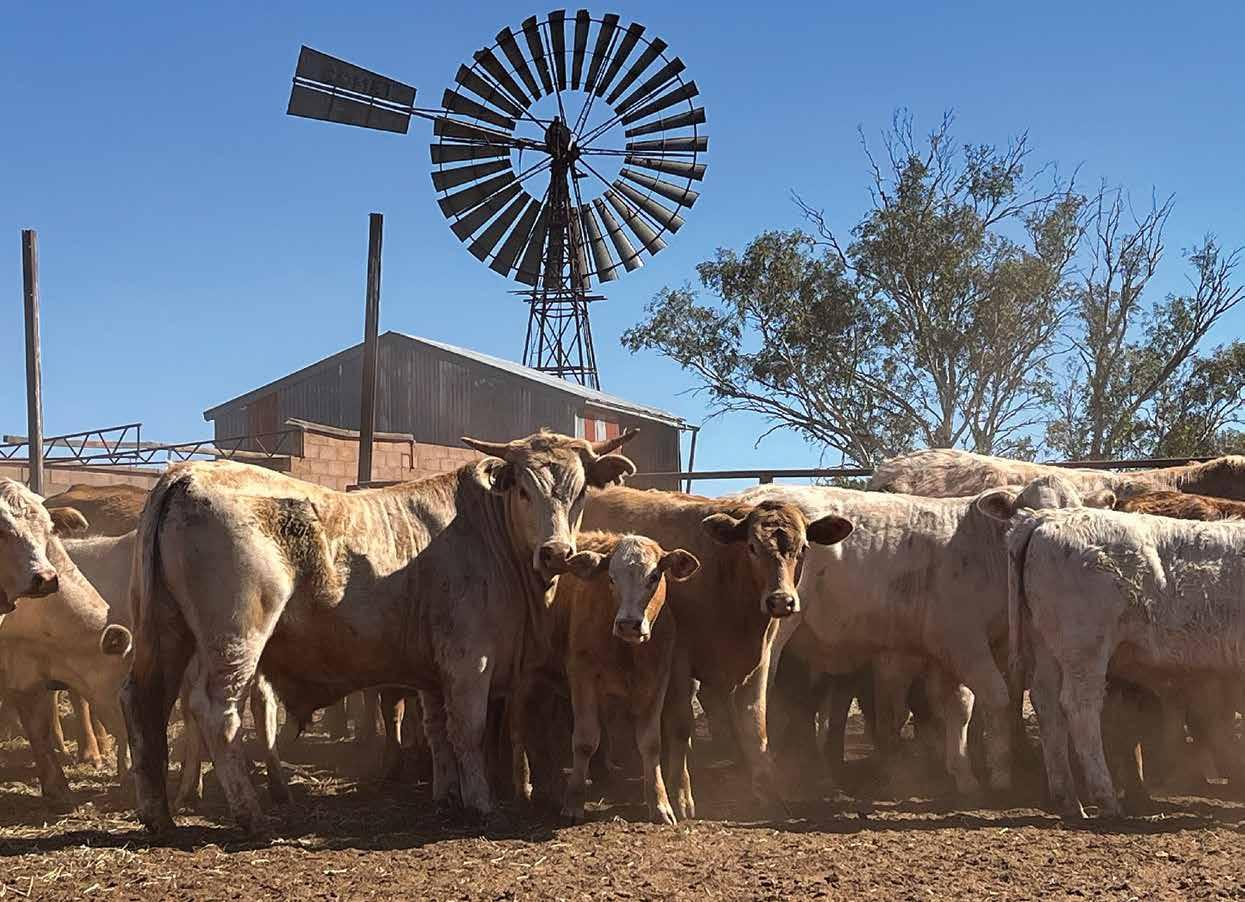
IT’S AN OUTLANDISH INTRODUCTION TO A CATTLE FARMER WHO, FOR THE MOST PART, SEEMS PRETTY DOWN TO EARTH.
The larger-than-life name tag is part of Gillian Fennell’s online persona as she and husband Mark share their life with followers, raising cattle on Lambina Station, a million-acre rangeland property in the Pedirka Desert, 450km south of Alice Springs in northern South Australia.
And Lambina is very outback. The closest shop is in the town of Marla, a 70km drive away.
Freight for the surrounding areas is delivered there once a week, meaning a long drive to collect or do the grocery shopping over rough roads. The mail and school work for their youngest child, Eleanor (8), is delivered by plane from Alice Springs to the letterbox on their airstrip at the back of the house, on a Wednesday.
“We hear them come in – they’ll drop stuff off and take off again,” says Gillian.
Eleanor will eventually head off to boarding school in Port
Pirie as her two older brothers have, only seeing their parents in the holidays. Gillian and Mark also went to boarding school as youngsters in Queensland and it was here they first met.
Sharing their life on the land online, with humour, images and short videos adds a layer of fun and creativity to their lives. The more thoughtful blog posts, and industry commentary helps followers see the realities of production behind the humour.
Gillian initially got into social media to see what other farmers were doing on their land.
“I found it a fascinating way to learn about other people and other agricultural systems in other countries. They all seem to have challenges, including with


their governments and policy. I’d like to think they’re learning about agriculture from me as well.”
And it wasn’t just farmers who began following her, watching what was going on in stock cameras set up around the station, the cattle and wildlife that regularly visited, unwanted trespassers and camels, appreciating her sometimes sweary sense of humour.
Social media also became her way to bridge the divide between farmers and their urban counterparts.
A lot of farmers are too focused on their own issues, Gillian believes, while it’s in their own best interest to reach out - especially to those in towns and cities.
“We need urban people to understand farming life better so they feel more connected to people living on the land and the countries’ food systems,” she says. “There’s a lot of negativities around farming and people often don’t make the connection we are real people. We may not have the exact same struggles or issues but we all want what’s best for our families, access to a decent education and health care – these are universal things.
“Someone has to extend their hand and I think agriculture has to do it first. We need to connect on a human level or nothing will ever change.
“We’re such a small number of people, and a small number of the vote base. No political party has to pay attention to us and our needs. We have all these people in the cities, who have no idea about farming, saying we need to protect the environment. We need these people in cities to also say we need to look after the
farmers too - to protect our production systems, to protect our food sources.”
Gillian has also been critical of conservatism within the agriculture industry’s leadership. Failing to engage as the industry faces new pressures including from climate change is doing their membership a disservice she believes, as it locks the industry out of senior level discussions around planning, strategies and policies.
“You lock yourself out of the room when, if you’re genuinely serving your members and your industry, you should really be staying in there until they turn the lights off and kick you out.”
With these big picture views on agriculture it’s perhaps no surprise that Gillian is an industry representative on the board of Livestock SA, as well as being on a couple of committees of Cattle Australia (Cattle Council of Australia).
This sees her periodically off the station at meetings and conferences, meeting new people and hearing their stories.
Her followers often get to follow along on these trips.
While Gillian loves the outback, she admits it can be a bit drab and as she’s a bit of a magpie, something sparkly is usually part of her ensemble when she heads off the station. It’s also why she called her recent start-up media/ communication business Glitterati Media.
Gillian admits station life was tougher than she expected when
BOARDING SCHOOL IS AN EXPECTED PART OF LIFE IN THE OUTBACK FOR STEPHEN AND ELEANOR.
she and Mark first settled in to help run the property 21 years ago after Mark’s parents decided they wanted a change to farming life in Queensland.
While Mark’s family had always farmed, Gillian had grown up in Richmond, a small town in northwest Queensland whose main claim to fame was Minmi - Australia’s best preserved 100-million-year-old dinosaur skeleton, and the marine reptile museum Kronosaurus Korner.
Travelling around with her dad when he was working as a station mechanic, and watching her grandfather shearing wasn’t enough to prepare her.
Nor was the contracting job she did with Mark when they first got married and she left her “cushy” office job to maintain and repair windmills on the Barkly Tablelands in the heat of summer when most of the work was done. This saw them both living rough and sleeping for weeks at a time in swags.
Climbing to the top of 40-foot structures with a great big spinning wheel on the front to do maintenance can be dangerous she says, and they had a lot of close calls. And coming across venomous brown snakes while
UREA IN FEED SUPPLEMENTS HELPS CATTLE TO BREAK DOWN NUTRITIOUS MULGA TREES.
climbing down wells to the pumping infrastructure at the base was also memorable. While windmills may be an iconic image of outback Australia, they are fast disappearing from the landscape.
A windmill will only pump when the wind is blowing, but there’s also no real way to stop it when it is blowing. Once the tanks and everything else are full, the water pumps out onto the ground. This is one of the reasons people have been moving to motor pumps which are easier to run and maintain.
On the station Gillian and Mark are transferring their last two windmills over to solar pumps which have a shuttle switch and will stop pumping automatically once the tanks are full.
“The sun shines pretty much every day, but we can go weeks without enough wind to pump water for the cattle.”
Completely off grid, power on the station has been a work in progress since they moved in. For a long time, they ran a generator. But this went off at 10pm and didn’t start up again until 6am. This meant no water during the night with the fridge and freezer also turning off with food going off quicker, especially in summer.
Gillian and Mark are used to the heat now and don’t think it’s anything extraordinary. But with no air conditioning in the early days, Gillian was really suffering when carrying her first baby through summer with temperatures hitting 45 degrees Celsius. To get some sleep, she ended up with a mesh gazebo set up on the front lawn with a bed in it. The sprinkler would water the grass and


when the power went off, she’d sleep in the gazebo overnight with a cool breeze coming off the wet grass.
When Alan was born, bottle-feeding meant boiling water with the gas stove and torch light.
For Stephen, born five years later, there was at least 24-hour lighting.
By the time Eleanor came along in another five years, Mark had designed and built a solar power
COMPLETELY OFF-GRID, A SOLAR POWERED MICROGRID SUPPLIES ALL ENERGY NEEDS.
system providing 24-hour power and water, and as a winter baby she even had a heater.
These days, the house has evaporative air conditioning. Not as power hungry as refrigerated air-conditioning but, if it isn’t humid, it’s enough, she says.
The solar system 15 years ago had panels covering the top of a 20ft container which was full of acid batteries needing to be topped up with water every week.
Mark’s recent upgrade sees a 17kW solar array with a 24kW three phase output microgrid supplying power to the buildings on the station. The panels are smaller and more efficient, with six lithium-ion batteries that look like bar fridges.
“That’s enough storage for our three dwellings and the work shed, and enough battery stor-

age to run all that for about two days if we get cloud cover.”
The output can be expanded to 25kW in the future if needed, with each of the buildings able to have additional solar panels added.
Falling component prices saw the upgrade come in at $60khalf the price of the original system.
Because they’re so isolated, contractors are pretty thin on the ground, and they need to be self-sufficient and do things themselves.
This has seen them build up all the equipment they need – loader, grader, backhoe, crane, and a couple of trucks, even if most of it is over 30 years old.
Mark’s repair and maintenance skills have also come in handy in recent years and enabled him to discover a love of flying. He is now happiest when in the air at the controls of the two-seater ultra-light gyrocopter they bought.
Marketed as a recreational flying machine and made in Germany, the AutoGyro comes in a box ready for home assembly. Much cheaper than a helicopter, the AutoGyro can cover hundreds of kilometres and can see Mark gone for six hours, says Gillian. Able to do their own servicing, the aircraft is also cheap to run. Their manoeuvrability at low speeds makes them ideal for life on a cattle station, although they aren’t meant to be used for commercial purposes like mustering and there are rules around how high they can be flown.
“He’s passionate about it and
takes it very seriously. If we could afford it, he’d love to have a helicopter,” says Gillian, whose airsickness sees her stay firmly on the ground.
Aircraft ownership, particularly fixed-wing, is popular among landowners in the area including for mustering while others use contract helicopter pilots.
Motorbikes were used a lot more for mustering in the past, but labour shortages and a lack of experienced riders with the skills to muster out in the bush - without stressing the animals too much, means smaller numbers are being used.
“A lot of blokes just like to chase shit but that’s not helpful to anyone,” she says.
The stony plains on the property also make riding at speed, for the inexperienced, difficult and dangerous.
Pedirka Desert covers around half the land and has undulating red sand hills covered in trees and native grasses. The Mulga wattle tree is common, and with an unusually long tap root, is able to withstand long periods of drought. It’s also very palatable to sheep and cattle, giving them both food and shade, with urea part of a feed supplement for the cattle which helps them to digest the woody matter.
Loamy clay soil makes up the rest of the property and, while it is stony, it grows good feed with enough rain.
AN AUTOGYRO SEES MARK ABLE TO COVER BIG ON-FARM DISTANCES.

Not surprisingly in this part of the country rainfall is never high - 80 inches annually in the extreme west falling to just 5 inches in the east, with drought fairly common.
This sees the couple running 5000 Charbray cattle - a cross between French Charolais cattle and American Brahman cattle. These hardy animals are well suited to the heat and desert conditions. Their light colouring helps keep their bodies cooler and they are also resistant to humidity, parasites and diseases. The challenging conditions mean they only breed from their own cattle which have naturalised here, as outside animals often don’t survive.
Because of the large distances on the rangeland and limited fencing infrastructure, over time Gillian and Mark have learnt to use the cows natural herding instincts so they move to new forage largely on their own.
By putting in more water points and then turning them on and off, the cattle shift themselves. This also helps to maintain biodiversity and the health of the country, by reducing overgrazing, says Gillian.
“They’ll graze out to a maybe 10km circumference from a water point, maybe 25 if they’re young cattle or steers.”
They also don’t control joins, having bulls in with the cows all the time. They have found the cows cycle naturally on feed availability and rain fall, and become fertile when conditions are such they will be able to raise a calf.
They do, however, make sure the bull size is matched to the heifer size, with only young bulls going in with maiden heifers so they aren’t being covered by big giant one tonne bulls, she says. Maintaining production through droughts sees them change weaning practices - taking calves off earlier, along with culling unproductive cows and other unproductive animals out of the herd, ensuring enough food is left for the productive animals.
They also try and breed traits that reduce the need for intervention for animal welfare with the focus on polled cattle, small birthweight bulls, big frame breeders with wide hips so calving is easier.
Having to handle the cattle through the yards alone, a lot of breeding effort goes into a quiet temperament (research has shown calmer cattle are also more heat tolerant than excitable ones).
This sees a difficult temperament as one of the four T’s they cull animals on.
The others are teeth which need to be in good order for obvious reasons, toes too long making it harder for animals to travel, and “bottle” teats that are large and difficult for calves to latch onto.
“We want them to live, breed and survive with as little human interference as possible,” says Gillian.
Because the cows are producing calves as conditions allow, animals are sent to market sporadically. But being a small operation, they are still able to maintain a good cash flow and remain financially stable.
Angus and Hereford cattle are very popular beef breeds in SA, says Gillian. With buyers less familiar with Charbray cattle and unsure how they will go in feedlots, the animals don’t do so well going through the yards.
Along with wanting to avoid agent and yard fees they sell their stock privately.

This has seen them recently buy a farm block 900kms south in the Flinders Ranges where they can stockpile large numbers of cattle to sell, and where prospective buyers can come and see them.
Purchasing a B-double Mack truck to get them there means they are now self-reliant with transport.
At 10 - 11 hours drive away, it is also within livestock transport guidelines before the animals would need to be unloaded and spelled.
It’s been a valuable addition to the business, says Gillian, as they also grow lucerne there. When they deliver cattle, they can then bring hay back to the station.
While Gillian’s industry involvement and activity on social media doesn’t generate revenue, it has seen her guest writing columns for agricultural media, making appearances at events and participating in conference panels.
Along with her boutique social media company she is also involved with Australian agricultural platform Farm Table.
Gillian and Mark can be found on Twitter/X @stationmum101, Instagram & Threads - @stationlife101, and Linkedin - Gillian Fennell.


JACK OWEN BOUGHT HIS FIRST BALER WHEN HE WAS JUST 16 AND STILL AT SCHOOL.
He grew up on a lifestyle block in Ladbrooks, on the outskirts of Christchurch. His mother’s family were farmers, and Jack always wanted his own block.
That first baler was an old conventional baler. Contracting with it seemed a good way to finance his aspirations. Also Jack just likes machinery and being out on the land.
Summertime baling also paid for his B Comm (Agriculture) degree at Lincoln University, which he finished in 2019.
“The contracting got busier and busier, so when I finished Lincoln, I went full-time.”
He still makes conventional bales, and has added round baling, wrapping and drilling to his repertoire.
THE BUSINESS IS FULLY EQUIPPED TO MAKE CONVENTIONAL HAY BALES AND ROUND HAY AND SILAGE BALES.
“Individually wrapped bales are big around here. There is a lot of silage trading to meet the needs of the dairy industry.”
Because he is so close to Christchurch there are also lots of lifestyle blocks in his district, and he has many as clients. He is also increasing his farming clientele, both dairy and arable.
He says farming is varied around the Ellesmere area.
“I had a couple of guys who were mentors and taught me and got me going. One was a local farmer, David Hight, and another was mobile mechanic Grant McCarthy.













“Both of those guys know machinery and they were there at the drop of a hat if I needed help to keep things going,” Jack says.
across ditch the PROFILED IN NZ’S RURAL CONTRACTOR & LARGE SCALE FARMER FEBRUARY/MARCH 2024, WE VISIT OWEN AG, IN CANTERBURY, NEW ZEALAND.

This was the start of Owen Ag. Jack started making conventional bales over summer beginning 2013.
FROM HIS BASE AT LADBROOKS JACK OWEN LOOKS AFTER DAIRY AND ARABLE FARMERS AS WELL AS LIFESTYLE BLOCKS IN THE ELLESMERE AREA.

Some soils are heavy and hang onto moisture through summer and there is also lighter country.
“Even the drylands hang on well in summer. This means we have a long baling season. We start in September and continue into May.”
Another source of income is buying standing grass and selling it, mostly as silage round bales. “A lot goes to the West Coast. I have some good clients who buy off me every year.”
Jack leases 20 ha and makes balage to sell plus he grazes a few head of cattle. He says the farming that he does and the contracting work well together. He would like to expand the farming side in future.
Most contractors struggle to find staff. So far Jack has had no problems. “I have one full time guy and two part-time guys. Hayden James is full-time and Ryan Gallagher and Ben Thornley are part-time. They are all really

good operators. They think outside the box and fix problems.”
When Jack started the business his grandad, Barclay Hall, was a big help.
“Grandad was helping me out and driving a rake well into his 80s. My father also helped me a lot in those early days.
“My dad, Andrew, was a rural banker but he would swap the desk for the tractor seat. My mum Anne still helps out a lot and does
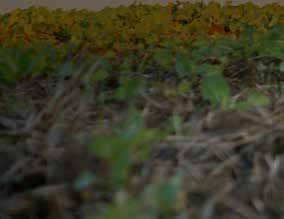











a lot of running around.”
He says it is easier getting staff as he has upgraded his gear.
“Now everyone wants to come and drive a tractor. A big part of it is knowing everyone in the area.
People support you.”
Keeping small and focusing on a couple of services has kept the stress levels lower than they would be if he had more staff.
“I am not trying to find 20 guys. It’s a sweet spot not being too

big, and there are not so many overheads. On a wet day it is much easier to keep Hayden and myself amused, rather than find work for lots of drivers.”
The stressors that remain are those that all contractors face, including price hikes for plastic and diesel, health and safety, and road travel.
Jack says the roads are the biggest challenge to their safety because the Selwyn district’s








































































Goldacres Series 2 sprayers are Australian designed, engineered & manufactured sprayers for your farming enterprise.
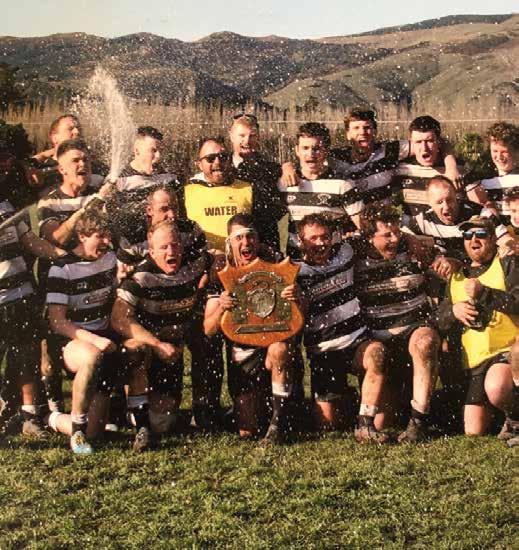
JACK OWEN IS CAPTAIN OF WAIHORA RUGBY CLUB’S SENIOR B TEAM, WHICH WON THE ELLESMERE COMPETITION LAST YEAR.
Having a less stressful winter job gives Jack Owen time to spend with family and play sport. He is an open-side flanker and captain of the Senior B team at Waihora Rugby Club.
“We actually won the Ellesmere competition last year, and the Under 85 team I play for won the National Club Cup up in Auckland.”
The rugby team is both a great way to just be human and hang out with friends while training. Because his team mates are farmers, it can also bring in more work.
“The team has been good at supporting me and one day I will sponsor them.”

CLIENTS FOR CONVENTIONAL BALES INCLUDE LIFESTYLE BLOCK OWNERS, HORSE STABLES, AND EVEN A FEW FARMS.

A DUNCAN ECOSEEDER IS A RECENT ADDITION TO THE BUSINESS.
population is growing quickly. “You’ve got to be on the ball with health and safety. We use industry guidelines for contractors.”
Jack’s tractors are all blue and it is a family tradition. “I grew up with New Holland. Grandad had them.”
He still has his first tractor, a 2003 New Holland TS90 with a 16x16 powershift transmission. “I have had the TS90 since I was 16. It is a bloody awesome tractor and bullet-proof. It is a little tractor but it has done everything.”
Now it’s on 9000 hours and semi-retired towing the conventional baler or raking. Theoretically it is worth nothing now as a trade in, but it remains useful.
The second tractor is a 2008 TS100A with a Quicke loader. Jack likes its short wheel base and zippy turning circle because he spends so much time in small paddocks.
“It is well spec-ed, the cab is a lot bigger than the TS90’s, and it is well laid out. It is a well-proven model.”
The newest recruit is a T6070 which Jack got to run his McHale Fusion combi baler. It boosts to 160 hp.
A fourth tractor is an old Ford 4610 that Jack bought off a Lincoln University researcher. It does some raking and is a handy spare tractor to have. “It’s been a great tractor.”
Mowing is done with a 3m Krone EasyCut disc mower. Jack says it follows contours nicely. It has a modular bar and is centre-swung.
Last year Jack replaced a module and was away again within hours. He then repaired the broken section to have on hand as a spare.
For some jobs, he gets a subcontractor, Max Templeton Contracting, in to do some mower conditioning.
Max has a Kverneland mower/ conditioner. He does the lucerne mowing because the conditioner does a good job of kinking the stems which helps it dry off faster.
Jack says Max has been another mentor, who has helped him out.
Owen Ag also has a four-rotor Lely Lotus tedder, a single-rotor Kuhn rake, and a V rake.
He bought the single-rotor rake to work in front of the conventional baler. “It makes a lovely fluffy row, especially in some of the
heavy crops we do.”
The V rake is bulletproof. It does the raking in front of the round balers and it has fully hydraulic steering.
The latest conventional baler is a New Holland BC5060. Jack likes the density of the bales it makes as well as its hydraulic pick-up and its camera, which allows him to see what is happening at the back.
“It also has a moisture meter. It gives a real time reading of the bale moisture. If a client thinks you should be baling but it is not quite fit you can show them the number on the screen.”
In good conditions the NH BC5060 can pump out 500 bales an hour. It was the first piece of equipment Jack bought new.
He bales conventionals for lifestyle blocks and horse stables. A few farmers also want conventionals. They are predominantly after grass hay, but he also makes some pea and barley straw. He does the straw mainly for clients but he also does some for himself to sell.
This season Jack added a McHale Fusion 3 Plus to his fleet. He wanted a baler/wrapper because they are more efficient and it means one less driver and tractor.
He wanted a McHale because he reckons they are the best baler in the world. With the Fusion 3 Plus, he can offer farmers the film-on-film option. Film-on-film is better at keeping air out of the bale. It makes a tighter bale and better quality silage because it eliminates mould.
“Film-on-film bales are easier to feed out, better to work with and easier to recycle. McHale bales look great with straight edges no matter what you are baling, and they stack nicely.”
The Fusion 3 Plus also has knives, so Jack and his team can make a short chopped product for dairy farmers who use feedout wagons. He has one sheep farmer who also prefers chopped bales.
“I like the robustness of the fixed chamber. It will bale anything. It is a well-built machine, and the best on the market. It is tested in tough Irish conditions. We also get heavy wet grass here in spring.
“Getting the Fusion has enabled me to expand my business and service a lot more farmers. It was a big investment but local
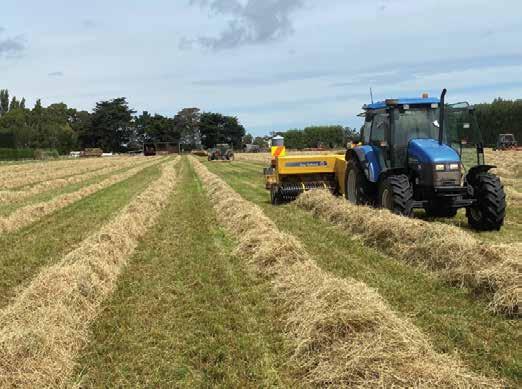
JACK OWEN GIVES HIS NEW HOLLAND BC5060 CONVENTIONAL BALER THE THUMBS UP BECAUSE OF THE DENSITY OF THE BALES IT MAKES AND ITS HYDRAULIC PICK-UP.
farmers have been good at supporting me.”
Before he had the Fusion, Jack’s round baler was a variable chamber New Holland BR7060. Now its main job is making hay bales in sizes up to 5 ft.
“The BR7060 makes a really good bale and it can bale hay, straw or balage if required.”
It is a 2012 model and has made 15,000 bales. It is also back-up for the Fusion, although it has not been needed.
Jack also runs a McHale 991 wrapper. “They are bloody good wrappers. They are fully automatic, really reliable and can keep up with the baler.”
He likes that the 991 wrapper tips bales onto their ends. Nowadays Jack uses it when he sub-contracts for people with a baler and no wrapper.
Although Jack does a little bit of drilling for clients, he mainly does it for himself. He uses a 2.5m Duncan 750 tine drill.
It is on three-point linkage, which helps for backing into corners and working around small paddocks. It is usually on the old Ford 4610.
“The Duncan 750 is a legendary old drill and it has been really good. I can use it to undersow or patch up wet winter ground that has been pugged. I use it to drill grass or winter feed crops like kale and oats.”
Recently Jack upgraded to a Duncan Ecoseeder with disc openers. Jack says it will cut through trash better. The 750 has done a good job under-sowing and drilling in cultivated ground but with the Ecoseeder, he can
drill a wider variety of crops and take on some bigger jobs.
This past season was wet so there were a lot of badly pugged paddocks. Along with his drill, Jack used a heavy roller to tidy them up.
As Owen Ag grows, Jack is slowly updating his gear. He aims to upgrade one bit of kit every year.
“I buy new where I can because I don't want downtime.”
All of his tractors were bought second-hand on low hours.
Jack’s go-to-place for machinery is the Norwood branch in Yaldhurst. “I have a good relationship with the sales manager, James Blackler. James has looked
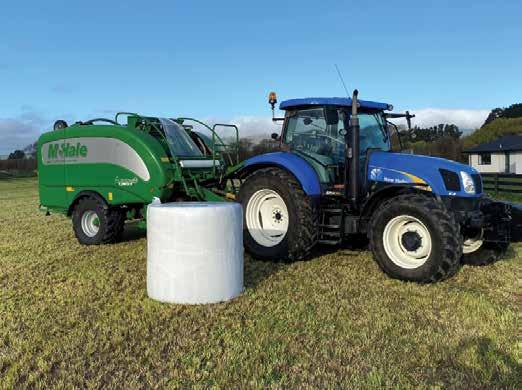
after me since I first started.”
Mobile mechanic, Grant McCarthy, does all the maintenance on Jack’s equipment.
A thriving contracting business always has someone who is good at talking to people. Jack is that person, and he spends all summer on the phone.
He likes it because he is the one with the ultimate responsibility, but he also likes doing the work.
“I like being flat out all summer. It’s a buzz. My motto is ‘Work hard and do a good job’.
“In this industry the reward for doing that is to get invited back and that is what I aim to achieve.”
In winter he takes on contract
CLIENTS OF OWEN AG LIKE THE FILM-ON-FILM BALES THAT THE MCHALE FUSION 3 PLUS PRODUCES BECAUSE THEIR SILAGE QUALITY IS BETTER, THEY ARE EASIER TO WORK WITH, AND THE PLASTIC IS EASIER TO RECYCLE.
work as a rep on the road with a feed assessment company. It keeps the income flowing, and also builds more connections.
“We test silage all over Canterbury. It keeps me out talking to people, which is a good way to make connections.”
JACK OWEN STATED HIS CONTRACTING CAREER MAKING SMALL BALES DURING SUMMER HOLIDAYS WHEN HE WAS ATTENDING LINCOLN UNIVERSITY.
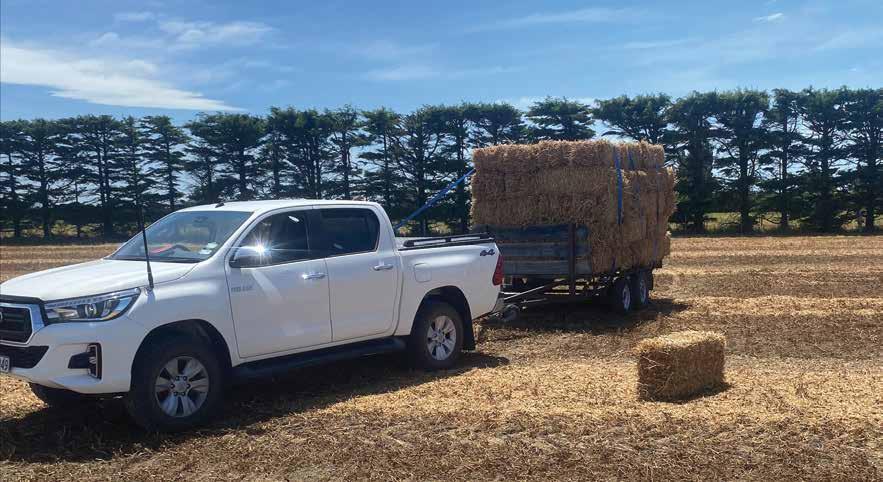
OWEN AGRICULTURE LOOKS AFTER FARMERS AND LIFESTYLE BLOCK OWNERS AROUND GREAT CHRISTCHURCH AND SELWYN DISTRICT.
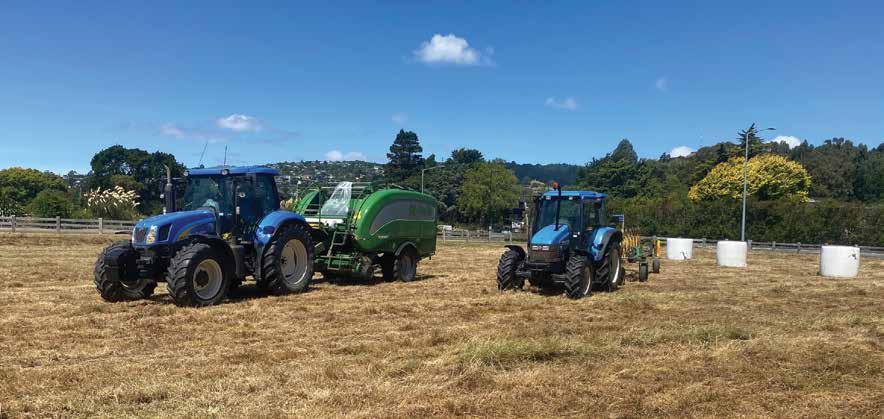

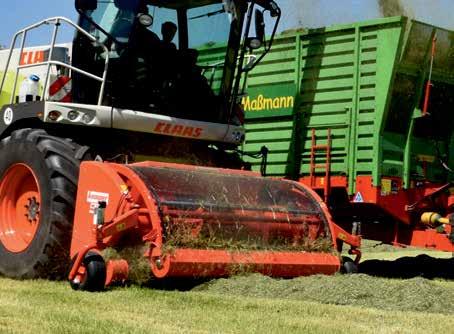

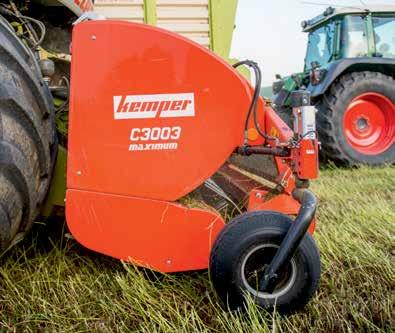





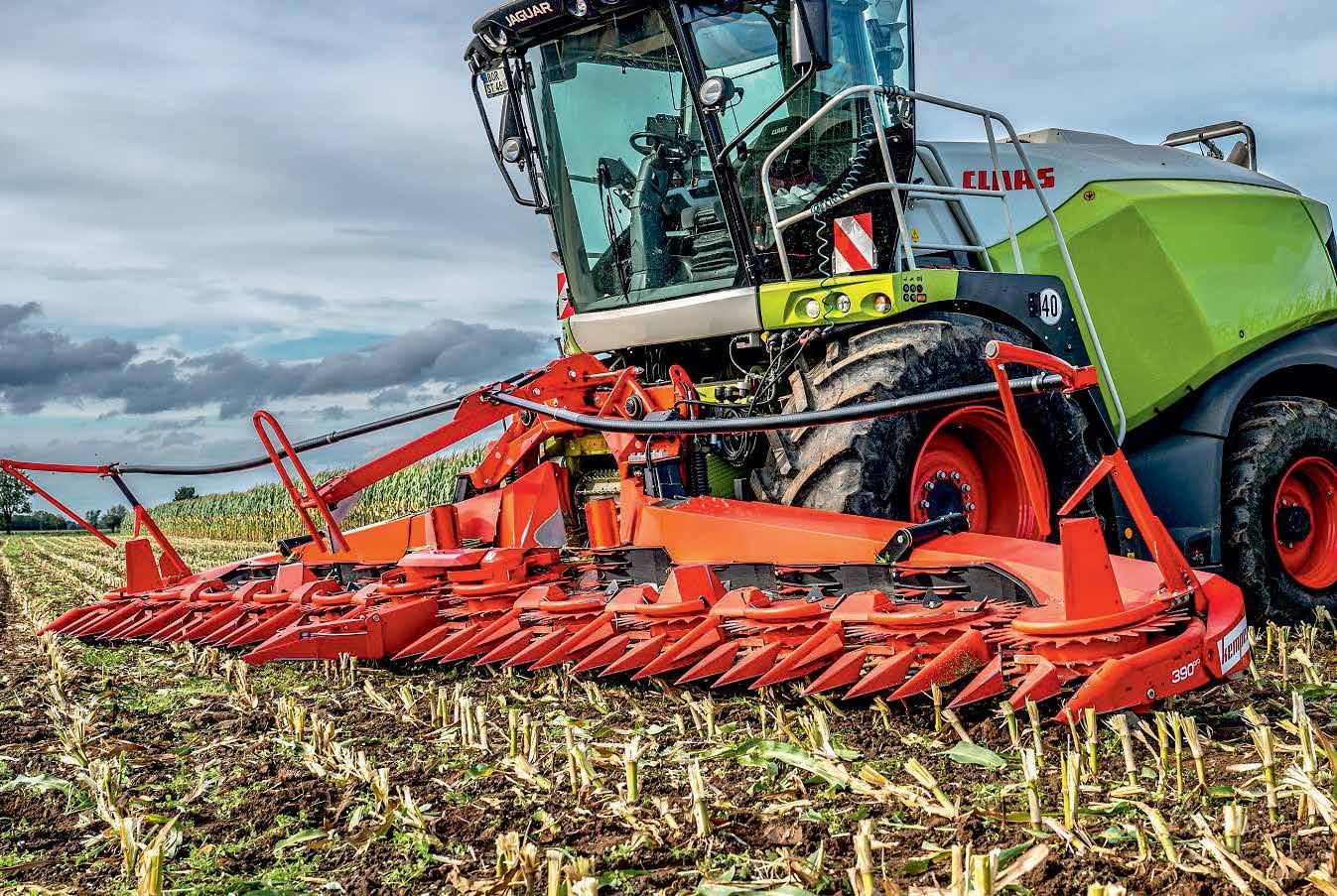

Big news from Kemper for the 2024 corn season is the introduction of the new 300 PRO and 400 PRO series corn fronts. Better durability and optimised plant intake creating higher throughput and longer service life make a new Kemper PRO Series the only choice!
Big news from Kemper for the 2024 corn season is the introduction of the new 300 PRO and 400 PRO series corn fronts. Better durability and optimised plant intake creating higher throughput and longer service life make a new Kemper PRO Series the only choice!
� 6.0m, 7.5m and 9.0m cutting widths for both series
� 6.0m, 7.5m and 9.0m cutting widths for both series
� Angle adjustable headstock
� Angle adjustable headstock
� Patented “Claw” gathering drums
� Patented “Claw” gathering drums
� New heavy duty blades, skids, pointers and towers
� New heavy duty blades, skids, pointers and towers
� Widening crop channel on 400 PRO
� Widening crop channel on 400 PRO
� Shorter, flatter gathering drums on 400 PRO
� Shorter, flatter gathering drums on 400 PRO
More info on the Kemper PRO series listed in this publication!
More info on the Kemper PRO series listed in this publication!
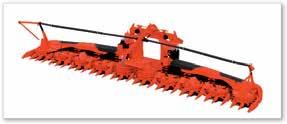
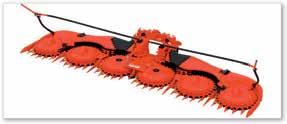




CONTRACTORS AND FARMERS USE TILLAGE TOOLS TO PREPARE SEED BEDS, DISRUPT WEEDS, INCORPORATE STUBBLE OR GREEN CROPS, AND BREAK UP COMPACTION. WHATEVER YOUR AIM, YOU NEED GOOD EQUIPMENT TO DO THE BEST JOB. IN THIS FEATURE WE LOOK AT THE LATEST CULTIVATION EQUIPMENT AVAILABLE IN THE AUSTRALIAN MARKET.
The introduction of Kuhn’s Optimer XL 12000 onto Australian shores has stepped up the competition amongst competitors in the tillage industry.
Designed for stubble cultivation, trash management, soil levelling and the destruction of green covercrops, Kuhn’s Optimer XL 12000 offers a whole host of new and innovative features designed to improve the efficiency and quality of work it performs.
Offering mounted or trailed models 12 meters wide, the Optimer XL 12000 caters to large scale operators.
With a variable working depth of 50 - 150mm, the Optimer XL 12000 is ideal for shallow stubble cultivation even when working with heavy crop residue.
There are 96 discs on the Optimer XL 12000 each with a diameter of 620mm. Each disc is 6mm thick prolonging the life of the discs by 20% in comparison to discs 5mm thick, ensuring quali-
ty, durability and, therefore, time and efficiency.
Taking into consideration the variation in distance off the ground across the 12 meters span, Kuhn has assured a consistent working depth by incorporating a ‘Steady Control’ system.
The Steady Control system controls each of the five segments independently across the machine.
The Optimer XL 12000 has been designed to increase material flow by limiting one disc per arm. The design also reduces the risk of blockages with greater clearances under the disc train and underbeam and between disc trains. With a variety of rollers available for the Optimer XL 12000, Kuhn allows the operator to choose the best roller for their desired result making it adaptable to for each user.
Weighing in at 13.7tonnes, the Optimer XL 12000 requires a

For high output sowing during stubble cultivation or seedbed preparation, Pöttinger has now equipped not only its Terria stubble cultivators but also its trailed Terradisc 8001 T / 10001 T disc harrows with a distribution system coupled to the Amico F front hopper. Now, soil cultivation and sowing or fertilisation can be done at the same time.
In just one pass, fertiliser or cover crops are sown directly into the soil using this resource-saving process. By feeding fertiliser into the raised flow of soil, it is mixed in and covered straight away.
The fertiliser does not lose any of its effectiveness and is immediately available for the plants. This process is suitable for seedbed preparation in spring or for replenishing nutrients with granular trace elements in autumn.
Cover crops are directly stimu-
lated to germinate because they are immediately covered and consolidated by the packer. This can be done during shallow stubble cultivation.
Driving speeds above 10 kph in combination with the wide working widths of 8 and 10 metres ensure an enormous output.
Large diameter, scalloped discs with a diameter of 580 mm slice into the ground and get the soil moving. The aggressive setting of the tools ensures reliable soil entry, even in the driest conditions.
The twin arm suspension system prevents the discs from deviating sideways on hard ground. This ensures that the whole surface is moved, which ultimately ensures uniform application of the seed material and fertiliser.
Setting the distribution rail with the outlet diagonal to the ground feeds the fertiliser or seed into the flow of soil.
As a result, the material joins the flow of soil to be deposit-
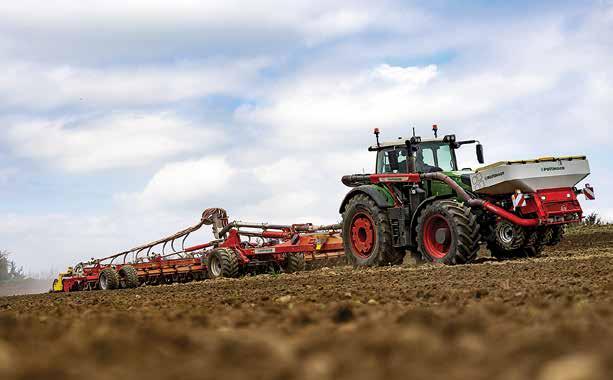
ed on or near the surface. This method is suitable for sowing greening or cover crop mixtures.
By setting the distribution rail perpendicular to the ground, the material is immediately mixed into the soil below so that it is deposited across the full cultivation depth.
The fertiliser and seed material is therefore distributed throughout the entire cross section or soil movement. During stubble cultivation, for example, compensatory fertilisation of potash or nitrogen can be used to accelerate the decomposition of straw.
The capacity of 1,700 or 2,400
litres and a division of 60:40 ensures a wide range of applications for the front hopper.
To ensure convenient operation, the Amico front hopper is equipped with ISOBUS as standard.
The material is applied using a single shoot process with a pressurised hopper system.
One or two metering units can be controlled site-specifically by the intelligent control system. Furthermore, the hopper can also be used in commination with third-party equipment thanks to the ISOBUS control system without any issues.
The Terradisc T with the distribution system for the Amico F front hopper is a high output solution for sustainable and strong plant growth.

minimum of 480 horsepower to operate.
The ideal operating speed is 15km/h that has the potential to cover up to 18 hectares an hour.
Kuhn’s design has also taken into consideration the need to trans-
port the Optimer XL 12000, and its design allows for it to be folded to 3 meters wide and 4 meters high for road transport with a hydraulic lock for extensions to ensure safety.
The innovative design and
quality of the Optimer XL 12000 allows it to stand out from its competitors as an efficient, low maintenance machine that will deliver consistent results to the operator.
Kuhn’s Optimer XL range is
available in mounted and trailed models started from 3 meters wide. Find out more about Kuhn’s Optimer XL range at; www.kuhn.com.au/crop/tillage-implements/stubble-cultivators/optimer-xl.
Moisture management on farmers’ minds with K-Line Ag range of solutions in good supply
With drier times still predicted for many of the nation’s farming regions in 2024, moisture management is set to become even more critical in order to maximise soil and paddock productivity.
Australian manufacturer K-Line Ag specialises in a range of high-quality and high-performance tillage equipment that has been serving the needs of farmers for more than 30 years.
“In a country like Australia, one of the driest in the world, farmers know just how critical moisture management is. It impacts crop growth and yield, and overall farm profitability, and if done well can lead to many benefits including improved soil health,
reduced erosion, better water use efficiencies and climate resilience,” said David Gibson, Brand Leader for CNH Industrial Seeding and Tillage, Australia and New Zealand.
“Ensuring soils are well-prepared and ready for rain and associated moisture collection can mean the difference between a great crop and an average one, particularly when good rainfall is hard to find.”
David said K-Line Ag, with its manufacturing base in Cowra, NSW, had developed a range of equipment specially designed for Australian conditions that worked to help optimise soil health and productivity.
The K-Line Ag TrackAttack® is a versatile and effective option when it comes to incorporating

Expectations of tillage machinery is getting greater and Grizzly Engineering’s Tiny 230H model is proving itself in the field as one of the most versatile and effective tillage tools you can buy.
If you are forced to have to wait for rain to enable you to get the desired results or the desired depth in the field, causing delays, ineffective tillage and unnecessary costs, there is a solution.
The Tiny 230H alleviates this problem and allows for the desired depth in just about all conditions. When most competitor disc tillage machines will merely cut a little line, the Tiny 230H will work to 150mm plus achieving a full cut-out and a full mix.
The Tiny range has an optional crumble roller which is proving very popular with farmers and contractors that want to size

moisture management strategies, offering a range of track options designed for various soil conditions and helping to minimise soil compaction and maximise moisture retention.
With the TrackAttack®, the issue of soil compaction is combatted by facilitating tramline farming, a method that limits vehicle traffic to designated areas rather than across the entire paddock. This is achieved by levelling out wheel tracks, ruts, and uneven terrain, the front row of discs slicing through the ground, loosening and moving soil onto the tram-line, while the crumbler roller follows behind, breaking down clods and leaving a flat, even surface.
K-Line Ag’s ripper range also works to solve soil compaction, featuring the MaxxRipper ® , ThunderRipper ® and LightningRipper ® .
“The practice of deep ripping to address compaction and allow for moisture pathways between the surface and sub-surface are-
as of the soil profile is an important aspect of well-prepped paddocks and our ripper range is designed to cater for a variety of farming operations and soil challenges,” David said.
The Trashcutter ® is an abovethe-ground moisture management solution, particularly well suited to zero-till operations. Its advanced design lays stubble to one side and then slices the stubble with self-sharpening discs into short lengths. With the Trashcutter®, more stubble remains in the soil, helping minimise both wind and water erosion.
“As farmers move through harvest and start thinking about planting next year, it’s a great time to do a stocktake of your tillage equipment and consider the K-Line range. It’s all Australian-designed and locally manufactured, ideally suited to our conditions and currently there are good stock levels available through local Case IH and New Holland dealers,” David said.
clods, want a flatter looking finish, and limit the surface area of the soil after working to save moisture. The option of hydraulic fold speeds up moving from paddock to paddock or job to job and the swing fold gangs on a rigid frame makes adjusting gang angles to suit job at hand easy and effective and ensures a reliable, even working depth across the machine.
Standard with 28inch discs and optional with 32inch discs on the 230H model (other Tiny models can have 32inch, 36inch and 42inch discs) give heaps of clearance and ability to wear discs down and still continue to work effectively.
With six gang angles to choose from, heavy-duty steel sections used and high-end Australian built and workmanship, the Grizzly Tiny230H is built with the Australian conditions and the
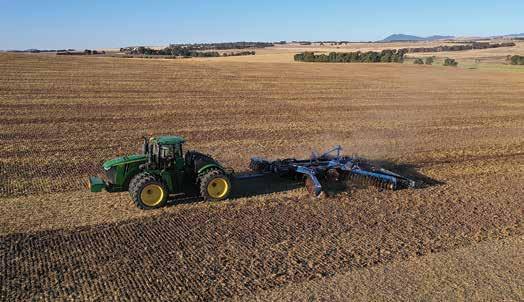
Australian farmer and contractor in mind.
Designed and manufactured right here in Australia in the Victorian agricultural centre of Swan Hill, Grizzly has built a name on building reliable, high performing ground-engaging equipment since the early 1980s, through that time building trust with Australian agricultural producers.
It’s the most versatile disc tillage machine on the market and
here to help farmers with their tillage needs.
The Tiny model not only ticks the boxes working soil, it also ticks the boxes in transport with most models folding down to 3.5m with a hydraulic fold option. As well, the ever-reliable Grizzly disc bearing system has a two year bearing warranty.
To find out more, you can go to grizzlyag.com.au or email sales@grizzlyag.com.au or call 1800 637 250.
Ground Gear Australia Pty Ltd offers a range of cultivation equipment for a vast array of applications, with specialistaion in hard-metal parts with tungsten.
Otico Farmflex have been the European leader in premium depth gauge wheels for more than 30 years and Ground Gear are increasing their stocked range of these premium press and depth gauge wheels for best practise agronomy when it comes to seed placement.
These wheels will fit to any precision planter with 16mm (or 5/8” mounting bolt), and are often the brand trusted by northern hemisphere manufacturers in the first instance. Many new machines coming from Europe are likely to have these wheels fitted from new. Where Ground Gear can help is with a replacement service at first change, as rubbers wear or seeder wheel polymer housings get damaged from stony soils, or just the sheer amount of hectares planted.
We stock press wheels for any 5-6 3/4 inch spacing direct seed drill including the following brands: Gaspardo, Great Plains, Allen and DD30 and Quantumdrills, and pretty much any heavy direct drill using a turbo disc, double disc and press wheel. For closing, we have a direct match in our Otico Farm-flex range.
Ground Gear also has lipped gauge wheels, where the depth gauging position of single bevel discs is critical for even seed emergence. These wheels are
sometimes referred to as cleaner wheels as they prevent the see disc from sledging, which can happen from sticky soil build-up, resulting in hair-pinning.
The following brands of disc seeder – Bourgault, Horsch, Avatar, Gaspardo, JD750 and Novag - with the disc cutting in an almost direct line, frequently use Otico’s very advanced rubber compound technology for precision depth setting.
Ground Gear supplies Boehlerit hard metal tips which have a patented tungsten wearing protection system, placed from the very end of the point all the way up the leading face,
The results of this technology are impressing customers due to the extensive wear they deliver.
Dirk from Axeford Farming has new Boehlerit points on his Terraland deep ripper-cultivator and says he’s very happy with how they have performed.
“They just sit straight on the tine, and once they’re on there, they wear very evenly – there’s no sideways movement in them.”
With heel and pin systems, the holders can loosen, leading to premature wear on one corner, as machines can often track slightly to the left or right as they work. However, Dirk says this isn’t an issue with the Boehlerit tips.
“There’s no deformations where one side will wear more than the other side,” he says.
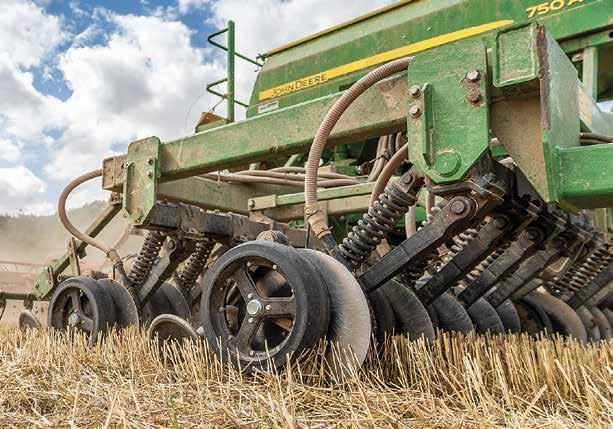

Forges De Niaux seeding discs come in 13.5inch & 15inch diameter with Ground Gear’s having developed modular CNC machined hub and bearing systems to get away from riveted hubs which fail prematurely in stony soil conditions.
The quality of the cut is a key factor in crop residue management. Thanks to their unique steel structure, Niaux disc blades get sharper as they wear as opposed to more conventional discs that show uneven wear and lead to blunt edges.
The flawless steel structure and better wear resistance of Niaux 200 disc blades allow them to remain sharp in any conditions.
Thomas Haymes of Haymes
Contracting in Gippsland, Victoria has been running the discs for the past season in soil ranging from heavy clays to light, abrasive sands.
“They’ve just completed 2800 hectares and they’ve still got life left in them,” he says. “They’ve been wearing really well, and since we’ve got less wear, we’ve got less pressure on the bearings and less issues there.”

Agrowplow has released updates to several models in its popular deep tillage range. The mid-sized AP52 has seen minor design updates, as has their 9.0 and 10.0 m AP82 ripper, which is popular with broadacre farmers in QLD, WA and SA.
The company has also released a new deep-tillage implement aimed at the cotton industry, aptly named the CP62 cotton plough.
This plough has been designed to enable cotton farmers to cut and bury stalks whilst simultaneously rebedding their paddock in just one pass.
The CP62 is a 6.0 m 3PL plough that can be configured as either a ‘side buster’ or ‘centre-buster’ and features #9 shanks that can rip to 600 mm.
Stabilisation wheels at the rear help keep it steady whilst the rear 7-furrower blades with 1-metre spacings create the grooves in the soil. Agrowplow is also developing a trailing flexi-roller option specifically suited to cotton farming to complement the machine.
The AP52, a 3PL-mounted plough builds on the success of its predecessor with several minor design improvements aimed at maintaining its position as a versatile mid-sized plough
for farms where heavier farm machinery will negatively impact soil compaction. It is available in 9, 11, 13 or 15 hydraulic or rigid shearpin shank configurations from 3.42 - 6.0 m working widths and can rip down to 450mm depths.
The larger AP82 features a ripping depth up to 600 mm, a trailing, 3-section, raisable ‘winged’ design, with 17 or 23 shanks. It is best suited for large-scale farms with tractors to match.
Agrowplow marketing manager Josh Whalan says broadacre farmers have benefited from the company’s large plough range known for its high performance in tough Australian conditions, with many reporting seeing positive yield increases of up to 1 tonne per hectare multiple seasons later.
“We designed our entire ripper lineup to give the same benefits of healthier soils and higher yields to any farmer, from mixed or specialised farms, all the way to the large broadacre enterprises.
“It’s about offering the right implement to fit the scale of your farm. For example, our rippers cover working widths from as low as 1.65 m all the way up to 12.0 m. We have an option for all farm sizes, including where farmers are looking for a solution to
Managing director of newly established Fordham Agricultural Machinery, Guy Fordham, has used his considerable experience to bring a new range of British built machinery to this part of the globe.
“Whilst working with farmers and contractors over the last three years, and during my time listening to our customers, I’ve found the need to source and supply machines that can provide remedial low disturbance sub surface loosening to alleviate compaction found in land that has either been compacted by heavy machinery, livestock and/or weather events,” he says. “Subsequently, after doing my research, we are extremely proud to announce that we have


deep soil constraints but don’t want to have to meet the input costs of a farm five times their size,” Josh says.
All updated Agrowplow models make use of the company’s high-breakout #9 shank assemblies. Featuring a narrow profile
to reduce drawbar requirements, full-length shinguards, and heavy-duty blades, the #9 Shank can also be outfitted with Agrowplow’s range of shank options, including fertiliser tubes, sweeps, mulch blades, furrowers, and inclusion plates.
become the importer for Grange Machinery from the UK.”
Grange Machinery produces a range of machines to help lower the cost of crop establishment, whilst improving soil structure and efficiency in the field.
Customers can invest in these machines to enhance and add versatility to their current farming system.
The beauty of these machines is that they are very adaptable and can transform existing machines that they may already have in the shed, providing them a lot of versatility.
The range consists of close coupled toolbars (CCT) that can be used in tandem with an existing cultivator, power harrow or other piece of equipment. They are available in 3, 4 and 6m mod-

els incorporating their low-disturbance tine and cutting disc. The Low disturbance Loosener (LDL) machines that incorporate their own packer roller are a stand-alone machine available in 3, 4, 5 and 6m machines. The Low Disturbance Toolbar (LDT) range is available in 3, 4 and 6m machines that can be used in conjunction with a seeder and/or cultivation machine.
In addition, they offer a range of strip-till machines incorporating three independent rows of cultivation discs that can be hydraulically adjusted whilst working in harmony with our low disturbance tine and point, allows us to create a perfectly cultivated row that is ready for a seed to be planted into.
See link: https://grangemachinery.co.uk/


• Finance from 0.99%* • 20% deposit • 36-month term
Now is the perfect time to invest in the quality and performance of Fendt hay tools, with an excellent finance rate and generous payment terms. Contact your local dealer.


Serafin Machinery are at the forefront of seeding and tillage equipment in the Australian farming industry.
They’ve been stocking a huge range of cultivators, speed discs, single and double-disc seeders and everything else in between since 2006.
They not only design and manufacture Serafin Australian-made machines, but also have exclusive rights to sell popular international brands from Brazil and Czech Republic.
Most notably, the Czech Republic brand Farmet has become one of Serafin Machinery’s biggest sellers because it’s possible to customise your machine to suit any farming operation which works for Australian farmers and contractors alike.
Big draw cards for the success of Farmet in Australia are its low-maintenance design requiring minimal adjustments, coupled with the capacity to handle diverse ground conditions. The extra steel line technology built into every Farmet product is
three times stronger than many standard machines in the market, ensuring durability and strength, while promising reliability in the field.
Serafin Machinery have built quite a rapport with customers who have backed Farmet products from day one.
Jason Dossetor from Benerembah, just outside of Griffith NSW is one of those customers. He has owned a 6m Triton 600 combined speed disc cultivator for a few years and says, “It’s a go-to machine”.
As an irrigation farmer who grows mainly summer crops including rice and cotton, he was looking for something more versatile than standard scarifiers, chisel ploughs and offsets. When he saw the Farmet Triton working at a field day, he decided to trial it on his farm and it hasn’t left since.
He decided to purchase the Triton because it takes the place of all those standard machines, cutting down on the number of passes required while managing different crops all at once. To


view Jason’s full testimonial video scan the QR code below:


Serafin Machinery have experienced a rise in demand for a variety of Farmet products as more farmers are becoming familiar with Farmet’s offering. Serafin listens to their customers feedback and continually bring new models into the country which are developed for Australian conditions.
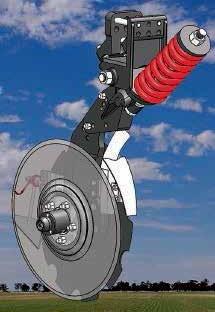




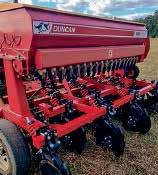

The most recent machine to hit the market is the Farmet Softer Pro 1250 range of multi-purpose, high speed disc tillage equipment perfect for the Australian farmer. Designed to work with modern CTF farm design and
optional processes for each pass, the Softer Pro is the professional’s choice. It’s a very low maintenance machine that requires little adjustment and can penetrate hard soils, handle high levels of stubble, and leave a beautiful seeder ready finish perfect for contractors who need to adjust on the go when working up the ground for various crops. Going between jobs is a breeze, with a 3m folded transport width. For more information on the 1250 range and hear from Serafin’s sales manager Rodney Dunn on the benefits this range will bring to farmers across Australia, visithttps://www.serafinmachinery. com.au/machinery/softer-pro/. Farmet is a force to be reckoned with and is here to stay in the Australian seeding and tillage industry. Serafins are selling as fast as they are stocking so give their sales team a call on 1300 737 586 or visit their website: https://www.serafinmachinery.com.au/machinery_ brands/farmet-brand/ to see the full range of Farmet products.

TTQ is continuing to focus on deep fertiliser for its machines – although the definition of ‘deep’ is variable by region –with around 30% of its machines adapted to handle this.
TTQ offers custom configuration which makes the machines suitable for all types of planting.
In a broadacre cropping situation, a band of fertiliser on double the row spacing is getting good results by ripping to one depth and, at the same time,
placing fertiliser shallower in the profile (ie., rip to 400mm and place fertiliser at 250300mm).
Some operators are using single, dual or triple outlets for multiple bands of fertiliser.
Custom-made 12m folding machines are becoming more viable with larger HP tractors, which is opening up a new level of efficiency for big broadacre operations.
Controlled traffic in conjunc-


tion with ripping and fertiliser is an option, with custom shank configurations and machine layouts. This overcomes a previous hurdle to adoption for those using controlled traffic.
The TTQ MTS machine in hydraulic or shear pin is ideally suited to cropping situations. It isn’t too heavy, is cheaper to buy and yet is incredibly resilient, while Raptor machines are a suitable option for operations that only have a dozer available to pull things.
We’ve seen a larger uptake of deep fertiliser in improved pasture programs – cattle farmers are essentially deciding to ‘feed’ their pastures. We also see this being used to address pasture die back which is seriously
The manufacturer of the Veloce range of disc harrows has released the biggest version yet of its trailing speed discs, promising faster pre-sowing cultivation for the larger broadacre farmer.
The MG-Veloce-T-1000C with a trailing folding frame is 10m wide compared to the previously widest version of 7m, and is designed to work down to a maximum depth of 10cm both for preparing seedbeds at the soil finishing stage and for crop residue management in minimum tillage applications.
The biggest point of difference with the 10m Veloce in this segment of the market is that it is ISOBUS-controlled, which
means it can be controlled automatically with a push of a button from the cab, so you don’t have to manually change settings such as depth on the machine itself.
The horsepower requirement for running the 10m version is 300-400hp.
The Veloce trailing discs comprise 510mm discs arranged in two gangs facing in opposite directions.
Other models in the Veloce range include trailing folding frames in 5-7m widths and there are also 2-4 m working widths in a fixed frame version. Prices for the Veloce trailing discs start at $112,860 including GST for the 5m version and the new 10m is $242,000.
afflicting some regions.
As land prices continue to soar, improving existing land is becoming more and more important and a single application of deep ripping and fertiliser giving returns lasting up to eight years in some areas, which makes the return on investment very obvious.
Pasture quantity and quality improvements can often be very invasive/destructive – especially with blade ploughs and cutter bars as this can put pasture out of use for many years whilst it settles down again.
However, using a deep ripper in the correct configuration means there is no locking up land – and it captures the next storm fall and starts growing.


Great Plains has made changes to its industry-leading Turbo-Max by introducing the VT1100 Turbo-Max, which has new features and options.
The VT1100 Turbo-Max frame has been redesigned to support new finishing attachment options. The updated frame also accommodates heavier transport axles and tyres.
Standard 20 inch Turbo blades are the best choice for soil with a medium to heavy texture or rockier areas where blade breakage is a concern. New optional 22 inch Turbo blades are applicable to lighter-textured soils that require a working depth greater than three or four inches. With Turbo blades spaced 71/2 inch apart, the VT1100 Turbo-Max provides true vertical cutting without the shearing caused by concave blades. Offset front and rear gangs achieve an effective residue cutting width of 33/4 inch when running at 0°.
Finishing reels on the VT1100 Turbo-Max are designed to reduce clods as they smooth the soil’s surface. New double finishing reels are engineered for soil that is heavier with a higher moisture content. Both reels flex and maintain even down pressure as they roll through the field. The single basket attach-
ment is well suited for drier, lighter soil conditions.
Both options are available with a choice of flat or round bars. Flat bars are more aggressive for breaking up clods, particularly in clay soils; round bars are the preferred option for lighter soils or rocky conditions.
One of the most unique features of the original Turbo-Max was its ability to angle the gangs from 0° to 6°. This popular feature is also key to the new VT1100 Turbo-Max.
All models are equipped with hydraulic cylinders to make gang angle changes on-the-go. Heavy, ductile cast spools keep weight in the gangs, ensuring reliability of the C-shanks and bearings.
7-lip seals on each side of the gang bearings lock in grease and prevent contamination. Additionally, the walking beam pivots utilize coated bushings, eliminating the need for tapered bearings and grease in pivot points. Drop axles pivot on anti-rotational pins, requiring no maintenance.
Rolling spike harrows finish the work of the coulters to create a level seedbed. They are the attachment of choice for most applications. Chopper reels are the best solution for tough residue situations and help prevent viney residue from wrapping

and plugging. They are designed to pin and bury residue, rather than rolling it back to the surface. Both are positioned between the blades and the finishing attachment.
The optional Implement Command system allows you to take control of the adjustment and monitoring needs right at your fingertips. This system allows you to set, adjust, and monitor your implement on-the-go and in real time – on your ISOBUS-compatible monitor in your tractor cab.
The VT1100 is the true vertical tillage solution for producers who take soil management seriously.
Great Plains defines vertical tillage as working the soil vertically to avoid the addition of horizontal layers or density changes.

It is important to avoid the creation of density changes because they create a barrier for the plant, which impedes root growth and water infiltration.
The plant’s roots dictate the overall health of the plant, as they deliver nutrients and water throughout, contributing to a higher yield. Without a strong set of roots, the plant becomes more susceptible to threats like wind and drought.
Maintaining uniform density in the soil profiles and preventing compaction layers is what vertical tillage is all about. By using a vertical finish tool, it will help establish an ideal seedbed to allow precision seed placement by the planter.
For spring vertical tillage, the tillage tool should manage residue, maintain density, and create the ideal seedbed for planting. When managing residue, the tool should chop plant matter into pieces that can be easily moved with a row cleaner and can flow through a planter. To maintain soil density, the tool should enter the soil perpendicular to the ground and cleanly cut through the residue. To avoid creating ridges, the tool should never move soil sideways.
As planting season nears, creating the ideal seedbed is vital to a successful crop. Vertical tillage equipment, such as those with a rolling spike harrow and reel combination, can help prepare an ideal seedbed by working the ground vertically to create a smooth, level surface, as well as at seeding depth.
The smooth and level consistency of the soil will help your planter navigate the field for precision seed placement and it will help ensure even emergence of your crops.
Amazone has added four folding mounted models to its third generation of Catros compact disc harrows.
Claas Harvest Centre Product Manager – Amazone, Blair McAlwee, says the four new models, available in working widths of 4, 5, 6 and 7 m, feature a smart frame design that allows quick and easy adjustment of the working depth.
“On many cultivators, the working depth is changed by tilting the entire machine and thus the positions of the front tools or following rollers and harrows have to be re-adjusted as well,” he says.
“Amazone’s smart frame concept’ makes adjusting the working depth much easier and more efficient.
“The working depth is adjusted by rotating the disc carrier arms away from the frame for a deeper setting or towards the frame for shallower work.
“The machine’s frame always remains parallel to the soil, meaning that the first and second row of discs always work at the same depth.
“A fixed linkage between the two rows of discs further helps to maintain a uniform working depth.
“Importantly, adjusting the working depth of the discs has no impact on the operation of any front or rear tools.
“This allows the operator to quickly match the working depth to suit changes in operating conditions, such as working across tramlines or headlands, without having to leave the tractor.”
The design allows stubble to easily flow through discs, regardless of working depth.
“The deeper the work, the greater the distance between the frame and disc arm and the following roller,” Blair says.
A range of tools can be added to the front or rear of the machine.
“The addition of a knife roller at the front shreds organic matter, such as stubble or catch crops,” Blair says.
“The individual roller segments provide perfect contour following.
“Alternatively, a crushboard can be selected if the focus is on seedbed preparation.
“In addition, a wide range of rollers and harrows are available for mounting to the rear of the machine to achieve perfect reconsolidation in all conditions.”
Seed drills and liquid manure applicators can also be incorporated into the system.
The Catros Series is highly regarded for its high productivity, versatility and low maintenance.
“Catros is perfect for a range of tasks, including breaking stubble and shallow seed bed preparation, right through to intensive incorporation and deep cultivation,” Blair says.

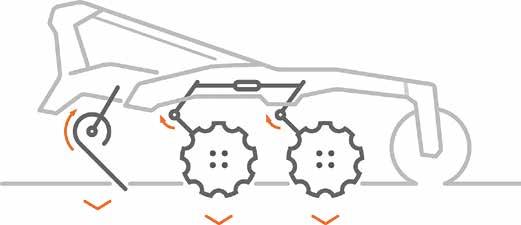
Working depth can be easily and simply adjusted.

The huge through-passage allows stubble to pass easily through the machine at any working depth.
“The low pulling power requirement enables high operating speeds, and high work rates with low fuel consumption.”
The 510 mm diameter Catros+

discs are suitable for working at depths from 5 cm to 14 cm and are available in both smooth, fine-serrated or coarse-serrated configurations.
The 480 mm diameter X-Cutter disc is available for shallower working depths from 2 cm to 8 cm.
Its wave profile guarantees full-surface movement and high mixing intensity at the same time.
The disc bearings have maintenance-free seals for reduced maintenance.
The disc bearings are located in the ‘shadow’ of the soil flow, protecting them from wear and allowing the easy passage of stubble and soil.
Each disc is individually suspended using pre-tensioned rubber spring elements to provide optimum contour following and maintenance-free overload protection.

WHETHER IT IS HUGE SEED BARS AND CARTS FOR BROADACRE FARMING OR SMALLER UNITS FOR RENOVATING PASTURE AND PLANTING WINTER CROPS, AN EFFECTIVE SEED DRILL OR PLANTER IS ESSENTIAL FOR GOOD CROP ESTABLISHMENT. IN THIS FEATURE WE LOOK AT THE LEADING IMPORTED AND AUSTRALIAN-MADE SEEDERS.
NEW CENTAYA-C SPECIAL HARROWMOUNTED SEED DRILL WITH TWIN-CHAMBER HOPPER
After Amazone introduced the Centaya-C Super harrow-mounted seed drill for combined grain and fertiliser sowing in autumn 2022, the Centaya Special pneumatic harrow-mounted seed drill now follows as the smaller version. The machine has a hopper capacity of 1,500 litres and is equipped with a twin-chamber hopper. Amazone offers the Centaya-C Special in working widths of 3m, 3.5m and 4m.
Efficient use of inputs
The hopper capacity of the Centaya-C Special of 1,500 l is divided in the ratio of 70:30. This enables two different materials in volumes of 1,050 and 450 l to be filled. The various materials that can be applied are metered separately and precisely in the ISOBUS-controlled Centaya-C Special. The harrow-mounted
seed drill with its infinitely variable electric metering allows seed rates of 0.5-400 kg/ha at a working speed of 10 km/h.
The conveying system feeds the applied materials to the coulters via the segmented distributor head. The simple conveying system transports the seed and the fertiliser to the coulter using the single-shoot process. The seed and the fertiliser are then sown into the soil via the coulter.
The combined application of seed and fertiliser promotes the seedling development in cereal crops. The seed and the fertiliser are applied together into the soil for effective use, meaning that the fertiliser is quickly made available to the plant.
Two different seed types can also be applied. For example, different seed rates can be metered and applied with the appropriate metering cassettes.
The Centaya-C Special can be equipped with the Micro plus micro-granular applicator. The 110 l hopper can also be mounted
on the pneumatic harrow-mounted seed drill. In this case, the material in the Micro plus hopper is fed into the main conveying system of the Centaya-C Special and is also applied using the single-shoot process.
It therefore enables the driver to apply a third material in the same pass. It is used for metering small quantities of materials, such as micro-nutrients or low seed rates.
The large hopper opening enables comfortable filling, and the seed hopper as well as the individual metering units can be easily reached via the loading board. The machine can be equipped with a quick-emptying device for fast seed changeover between jobs. A storage rack can be ordered as an option to accommodate additional sacks of seed.
The 1,500-litre split seed hopper means that the Centaya-C Special is extremely productive. The hopper profile ensures a low lifting power is required, since the metal seed hopper is tilted a long way forward towards the tractor.
2 coulter systems, 2 row widths
Amazone offers the harrow-mounted seed drill in working widths of 3 m, 3.5 m or 4 m with either the RoTeC single disc coulter or TwinTeC Special double disc coulter. The machines can be ordered with a row spacing of 12.5 cm or 15 cm (in working widths 3 and 4 m) depending on the customer requirement.
The Centaya-C harrow-mounted seed drill can be combined with the various soil tillage implements via QuickLink. Depending on the requirements, the Centaya can be coupled with a KE rotary harrow or a KX or KG rotary cultivator. It is also possible to combine the Centaya with the CombiDisc compact disc harrow on very light soils.
Amazone is expanding its range of precision seeders with the new trailed Precea 9000TCC and 12000-TCC models, in working widths of 9 and 12 m respectively. This variant, which has been developed specially for large-scale farms and contractors, stands out with its high-performance overpressure singling, large tank capacities and innovative Central Seed Supply seed delivery system. The high-precision seed placement ensures optimum field emergence, even at increased forward speeds of up to 15 km/h.
Central hopper concept –row-by-row singling
For exceptionally high work rates and reduced fill times, the new Precea-TCC features a central seed hopper with a capacity of 2,000 l for up to two big bags. The new Central Seed Supply seed delivery system carries the seed from the central hopper to the singling units via an air stream. There, the seed for each row is temporarily stored in a small reception unit. Once this reception unit reaches the maximum fill level, the air stream is automatically cut off, thereby shutting off any further seed supply. When the fill level decreases, the air stream restarts automatically and conveys seed again from the main hopper to the individu-
al rows. Thanks to the intelligent air stream system of the Central Seed Supply, every singling unit is independently supplied with seed, without the need for complex sensor systems or electronic controls.
Precise singling across all rows
For seed singling, Amazone uses its precision PreTeC singling units, whose functionality is based on the overpressure principle. This means the seed is pressed against the singling disc by air pressure. The seal rotates along with the singling disc, which considerably reduces the power consumption of the electric drives across the individual rows. The remotely controlled, automatic SmartControl stripper finger adjustment is coupled with the optical sensors and effectively prevents any misses or doubles. Meanwhile, the electrically-driven singling disc turns in relation to the forward speed and desired seed rate; conveying the seed towards the propulsion channel. At this point, the contact pressure is broken, the seed is shot precisely into the seed furrow, caught by the catcher roller and then securely embedded in the furrow bottom.
The furrow formers ensure the precise seed placement. Two carrying rollers and the high-down force, hydraulically adjustable coulter pressure ensure uniform depth control. For even greater convenience, Amazone offers the SmartForce automatic coulter pressure regulation. This ensures that the set contact force remains constant for a consistently uniform seed placement, especially in variable soil conditions.
The ElectricDrive electric metering drive allows the desired seed rate to be conveniently set via the ISOBUS terminal and serves as the basis for precise, part-area, site-specific rate control using GPS and field zone maps. In addition to this, Section Control actively saves seed row-by-row in wedgeshaped fields and on headlands, particularly useful at these large working widths. Ideal conditions are also provided for mechanical weed control with a hoe.
bends
The electric metering drive to


the individual rows makes it also possible to maintain an evenly-spaced placement across the entire working width, even when driving round bends. A yaw sen-
sor is used to calculate the difference between the forward speed on the inside and outside of the bend.
The innovative CurveControl then adjusts the speed of each singling disc accordingly, ensuring that the seed spacing remains uniform, even when seeding around bends. The even spacing allows the plants to be adequately supplied with nutrients. This results in uniform crops and ensures even ripening.
For the simultaneous application of fertiliser, the Precea-TCC is equipped with an easily-accessible, twin-chamber hopper with

Western Australian grower Darren Inkster said a largely timely rainfall season at Beaumont contributed to another solid harvest result over the family’s properties in the area recently. However, he said, constantly improving seeding system technologies also were helping to grow better crops.
The Inksters crop 4600 hectares to wheat, barley and canola over two properties including their Sparkle Hill home farm, as well as on share-farmed land, all mostly north of Beaumont.
The country ranges from traditional sand over clay on the home farm through to heavy limestone soils further north of Beaumont and it received 350-450 millimetres of rainfall last season.
“Even though the season shutoff, we generally received rainfall when we wanted it and we had good subsoil moisture after recording 600mm the previous year,” Darren said.
Grain yield averages at harvest included 3.2 tonnes/ha for the wheat, 3.5t/ha for barley and 1.5t/ha for canola.
“We enjoyed good opening rains in April and most of the canola was in before Anzac Day,” Darren said.
He said seeding equipment upgrades in recent years also were playing a key role in the improving crop production.
“The technology is just getting better and better and it’s probably the reason for the better crops.”
For their seeding equipment requirements, the Inksters had a strong relationship with local machinery dealer, Staines Esperance, and now with its successor, McIntosh & Son.
“Earlier, we went to a hydraulic tine with a Morris C1 and then C2 (Contour) bar and now we have an 18-metre Quantum (air drill),” Darren said.
He identified the Auto-Pack feature on the Quantum air drill as one of the most exciting technological advances and said it was easy to operate after becoming familiar with the system.
Morris Auto-Pack automatically adjusts the air drill’s packing pressure according to the soil conditions, providing for correctly closed and packed furrows in order to achieve an ideal seedbed environment.
“Morris are always adapting to the Australian market and with the Auto-Pack, you get a good, firm pack around the seed,” Darren said.
“Those who haven’t got it (the technology) will probably be flatout trying to get it.
“Even if it starts to get dry in heavy country, I reckon with the uniform packing around the seed, we are getting better establishment.
“In sandy soils, we have also seen some of the best establishment of canola.”
In addition to Auto-Pack, Darren said Auto-Lift technology with the Morris Quantum, which allowed for automatic lifting and lowering of tines, made headland turns an easy task.
He said end-of-row turning, which will work in conjunction with their Topcon X35 controller and help achieve accurate, hands-free turns, would be their next seeding step.
The Inksters have been impressed by the large flotation tyres on the Morris Quantum air drill, also compared with the tandem wheel configuration on their previous C2 Contour bar.
“The C2 wheels used to come

WA grower Darren Inkster, Beaumont, pictured overlooking a Morris Quantum air drill with Duncan Murdoch, McIntosh Distribution, during the Dowerin field days last season, says latest technological advances with the Morris bar are improving the family’s crops.
off the ground occasionally and we did have some problems with them in wet seasons, but there is no issue with the big Quantum tyres and you hardly even see a footprint. You don’t see where it’s been,” Darren said.
Set on 25-centimetre tine spacings and comprising a pairedrow seeding boot arrangement, the air drill has encountered no major concerns with stubble handling.
“It’s actually handled the stubbles a lot better than the C2,” Darren said.
He said the stainless-steel air kits and plumbing configuration across the bar was another key strength with the Morris Quantum.
“Someone has spent a lot of time on it, and now with the Raycol heads, rather than a fan system, it has been much better.”
The narrow folding width of the Quantum air drill also allows safer transport between the Inkster’s properties.
The air drill is hitched to an 18t, four bin Morris 9535 tow-between air cart, allowing for deep banding of urea fertiliser.
The cart completed its seventh season last year and was one of
the first from the manufacturer in the region to feature its Input Control Technology (ICT) to help eliminate seeding overlap and save on seed and fertiliser inputs.
“With our paddocks being not so square and having triangular corners, the section control has been a big benefit and you can see each section dropping-off as you go. We could be saving 5-10 per cent on the seed and fertiliser,” Darren said.
“With the rollers and with the section control being independently driven, we’ve hardly had any issues.”
The Morris 9535 air cart is filled from a Tornado 5-in-1 bin or belly dumper via a Brandt conveyor.
The seeding rig is pulled by a New Holland T9.600 tractor and Darren said when they update it, they would also look to upgrade the air cart.
“We want a bin that will do 100ha in daylight hours, and then fill-up for the night with plenty of commodity on-board. At the moment, we can do about 70ha,” Darren said.
“We will also move further towards a controlled traffic setup.”
a total filling volume of 6,000 l. Each hopper chamber has its own electric metering unit that is connected to a distributor head, meaning that half-side shut-off is available as standard. Fertiliser is placed via the FerTeC twin HD fertiliser coulter.
The relationship between the placement depth of the fertiliser
and the seed sowing depth is set only once. If the sowing depth is subsequently changed, the fertiliser placement depth is automatically adjusted in relation to the seeding depth.
The Precea-TCC is offered with 12 or 16 rows for row widths of
70, 75 and 80cm. A telescopic axle is available for the running gear of the Precea.
During field operation, this allows the position of over-sized tyres to be adjusted so that the wheels run between the seed rows, preventing compaction directly beneath the seed rows. With the wheels fully retracted,
the Precea-TCC can be conveniently transported by road with an overall width of 3 m.
As of autumn 2023, the programme will be rounded off with new models for those closer spaced row crops, such as beet, rape or soya beans, with row widths of 45 and 50cm in 18 or 24 rows.
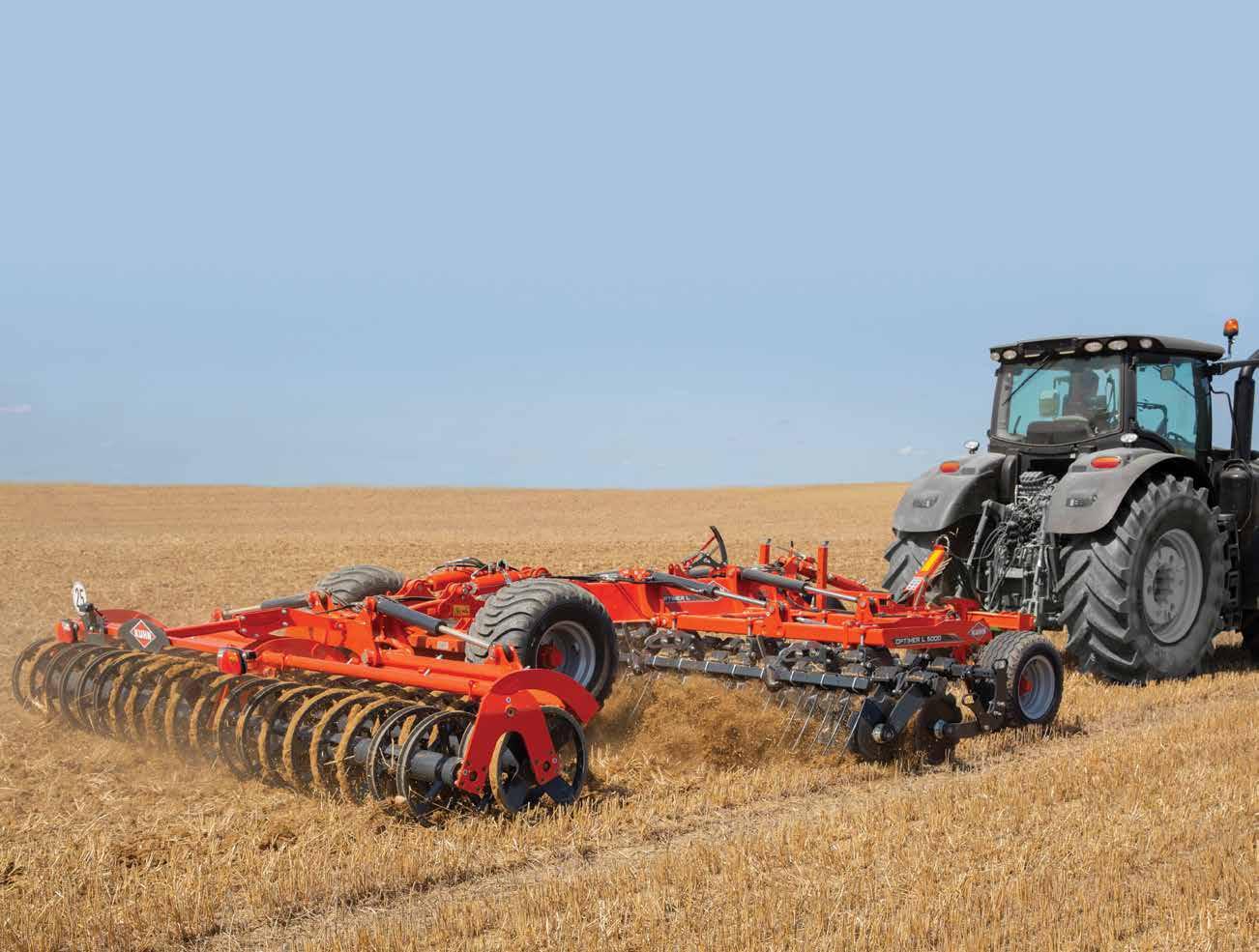
Reduce fuel consumption and enhance seedbed preparation.Hydraulically controlled to guarantee an even penetration of discs across terrain in all conditions.

Incorporating cover crops in spring, stubble cultivation in summer and seedbed preparation in autumn, the Pöttinger Terradisc compact disc harrow is suitable for a wide range of applications throughout the arable season. The Terradisc compact disc harrow is available with working widths between 3 and 10 metres.
The results produced by a disc harrow depend on the stability of the disc mounting. The soil is moved effectively only if each disc cultivates without any deviation.
The central element in this respect is the Twin Arm system. This features mountings that have two disc carriers each.
The wide clamping bracket reliably guides the 580mm diameter discs through the soil. It also prevents lateral movement, even in heavy soil and dry conditions.
The disc carriers are implemented in high strength cast iron, are extremely resistant to
stress and have a long service life. Rubber elements serve as overload protection and allow an upward movement.
High volumes of organic matter can easily be handled by Pöttinger Terradisc compact disc harrows thanks to their high frame clearance. The aggressive angle of the discs enables homogeneous mixing of soil and plant residues.
The working depth of 5 to 15cm is regulated using swing clips, which are easily accessible from the front of the machine.
The working widths between 3.0 and 10.0 metres listed for the Terradisc models correspond to the effective working width. This means you get maximum efficiency with the highest output.
Intelligent, efficient sowing with Pöttinger
Terrasem seed drills combine efficiency with the highest level
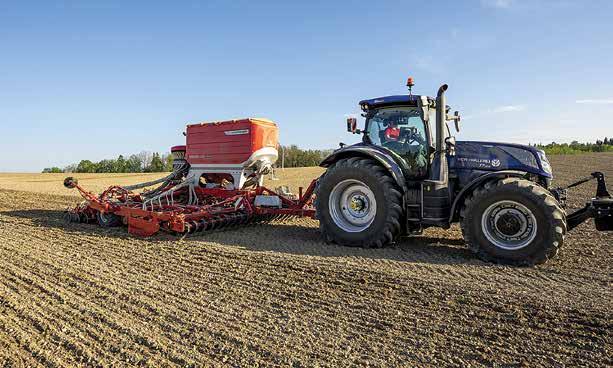



of flexibility and precision seed placement. In order to comply with feedback from the field in terms of making machines easier to use, the new Profiline comfort control system has been developed for universal seed drill technology.
Convenient operation
Profiline is the comfort control system that covers all the hydraulic functions of Terrasem universal seed drills. The machines are supplied with oil by the tractor’s load sensing connection, and all movements are controlled electro-hydraulically via a hydraulic block. The machine is operated by pressing a button on the control terminal or automatically by the task controller using Section Control and Variable Rate Control. All the tools are positioned automatically and precisely. The fan speed and coulter pressure are also controlled automatically. Set precisely and saves time During operation, the tools can be precisely adjusted to the site specific conditions. Independent of Section Control, the lifting and lowering sequences can also be set based on time or distance travelled. It is also possible to
deactivate individual tools. Intelligent control can be used to limit the vertical lifting height. Shorter lifting and lowering times allow faster turning times at the headland. Sensor monitoring enables the machine to fold and unfold automatically.
Headland control
The headland control function stops and restarts the machine precisely at the headland. Without a task controller, this function is controlled at the touch of a button. With a task controller, lifting and lowering is done automatically using the TC-GEO/ TC-SC signals.
Task Controller Geo
Enabling Task Controller Geo and Section Control means that application maps can be used to operate the machine.
The working depth of the disc harrow, coulter pressure and seed/fertiliser rates are then controlled automatically on a site-specific basis.
This allows valuable resources to be used efficiently and saved as a result.
Pöttinger proves its expertise in digitalisation by making the Terrasem models agrirouter-compatible.






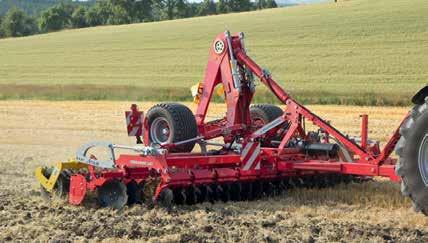

Roots in Austria, at home throughout the world.
Roots in Austria, at home throughout the world.
Innovative agricultural technology for more than 150 years
Innovative agricultural technology for more than 150 years
Highest functionality and productivity
Highest functionality and productivity
Efficient and sustainable farming
Efficient and sustainable farming
Forage conserving solutions guarantee best forage quality
Forage conserving solutions guarantee best forage quality
For more information on our product line contact us at (03) 8353 2770, www.poettinger.com.au
For more information on our product line contact us at (03) 8353 2770, www.poettinger.com.au
Introducing the cutting-edge Bourgault 4420 DK™ seeder: revolutionising precision farming
Leading agricultural equipment manufacturer, Bourgault Industries, is proud to unveil its latest innovation, the Bourgault 4420 DK ™ seeder. This groundbreaking implement sets a new standard for precision seeding, combining advanced features with expert design to enhance farming efficiency and yield.
Purpose-designed and built for Australian farms by the world’s leader in air seeding technology, the Bourgault 4420 DK seeder accommodates the latest advancements in farm machinery to enable growers to experience unmatched precision, efficiency, and adaptability in their seeding operations.
What truly sets the Bourgault 4420 DK seeder apart is its rigorous testing and design process. Developed in partnership with Australian farmers, this implement is tailored to meet the demands of local agricultural conditions. The result is a robust and reliable tool that stands up to real-world challenges.
After much engineering and tailoring the new 4420 DK seeder to suit Australian farms, Bourgault Australia General Manager, Craig Christensen, is excited to introduce the seeder to local growers.
“The 4420 DK has been developed specifically for and tested in the Australian market over several years in what was a fantastic process of collaboration with local growers to ensure we deliver exactly what they need on-farm,” says Craig.
“Using the new Bourgault 4420 DK seeder, we’re expect-
ing growers to achieve great results.”
Boasting an all-new frame design, the Bourgault 4420 DK seeder is available in sowing widths of 12 meters and 18 meters, catering to diverse field sizes and requirements.
With row spacings of 250mm and 300mm, growers can gain unparalleled flexibility in crop management.
Plus, the incorporation of Hi-Flotation™ tyres—a Bourgault standard feature—ensures minimised soil compaction, further promoting healthy crop growth.
A highlight of this remarkable equipment is the novel twin-tine DK™ (Deep Knife) opener, a result of cutting-edge engineering. This innovative design penetrates the soil to greater depths to facilitate improved fertiliser separation and precise seed placement. The result is an optimal environment for seed germination and growth.
Using the new 4420 DK seeder, growers can now experience enhanced control using the on-the-go adjustable hydraulic breakout, offering a breakout force range of 68kg to 450kg. This dynamic feature promotes adaptability in varying soil conditions, resulting in consistent seed depth placement and uniform crop emergence.
The narrow 5.5m transport width, applicable to both 12m and 18m models, demonstrates Bourgault’s commitment to transportation convenience and streamlining movement between fields to reduce time and effort.
The option of TTC™ coulters optimises soil throw and residue management in high-stubble

fields. The equipment is Streamliner™ compatible, and farmers can opt for a 4,800L onboard liquid tank for added convenience.
Farmers will appreciate the simple depth adjustment system, utilising shims on the main frame cylinders. The Bourgault 4420 DK seeder empowers farmers to swiftly fine-tune seeding depths according to their specific requirements.
Proudly celebrating its 50th anniversary of delivering precision air carts, drills, and seeding equipment, Bourgault Industries remains as committed as ever to driving agricultural excellence through innovation.
Bourgault’s mission is to design, manufacture, and distribute the highest quality, most durable and reliable farm equipment in the world whilst remain-
ing affordable and exceeding the expectations of the most intensive Australian operations.
The new Bourgault 4420 DK seeder is a testament to this commitment to enabling Australian growers to achieve optimal seeding application, germination and growth with solutions that are purpose-built for them.
“Bourgault Australia has distribution centres to cover both Eastern and Western Australia and dealers across the country,” says Craig. “We have high stock levels and, with two assembly plants, we can spare growers lengthy wait times by delivering the best local service.”
For more information about the Bourgault 4420 DK seeder and its features, chat with your local Bourgault Australia representative on +618 9399 9700.

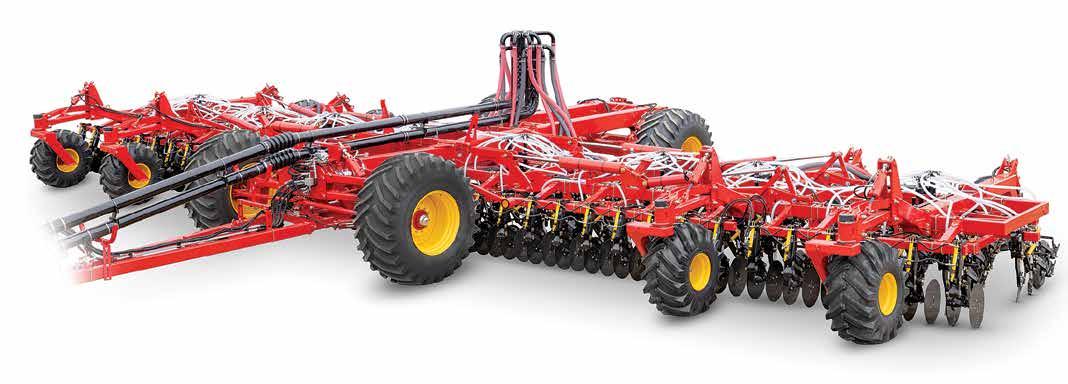
In-furrow equipment manufacturer, Liquid Systems (SA), is becoming the preferred option for most air carts in Australia.
Based in South Australia, Liquid Systems has been supplying liquid application systems around the world for over 20 years. Liquid Systems are known for their build quality, easy operation and reliability, with great product support.
In Australia, Liquid Systems has been supplying liquid kits that are factory-fitted at McIntosh Distribution in Western Australia to Morris air carts since 2004.
Since 2010, Liquid Systems have been supplying John Deere dealerships with a couple of dealer-fit liquid-ready kits for John Deere’s 1910 and C650 air carts.
In August last year, at the Dowerin Field Days in WA, they released a new liquid-ready cart range with CNH Industrial for Flexi-Coil Australia and Horwood Bagshaw, both set for production in Mannum early 2024.
Andrew Kissel, Product Manager for CNH/Flexi-coil Seeding and Tillage ANZ, says the relationship between his company and Liquid Systems just made sense.
“For us, we didn’t have an option for liquid over granular fertiliser until we worked with Liquid Systems.
“They are a phenomenal business partner and a key part of our business,” he says. “For us, dealing with Liquid Systems was a no brainer. They are incredible at what they do, they have the experience and they have a great reputation.
“It just made sense.”
“This latest release with CNH required quite a quick turnaround,” says Samantha Bell, Liquid Systems (SA) Marketing and Operations Manager. “Fortunately, our product model is so flexible and dynamic, we can easily adapt the liquid kits to any size implement, ranging from 18ft to 120ft seed drills and planters with no problems. We have an amazing team of people, which also helps.
“With liquid inputs in-furrow, it’s all about efficiency, getting
the right product in the right place at the right time at the right rate, the 4Rs,” Samantha says. “And we provide the equipment to do just that. It targets inputs right where the seed needs it and boots germination right up out of the ground.
“It’s a no brainer going from broadcast application of a dry fertiliser to in-furrow band which is super-efficient and targeted,” she said. “Our systems’ level of accuracy and consistency means you’re not wasting product. So, for budgeting, it’s a great tool and with even application right across the paddock which also helps improve yield.”
Liquid Systems has a dealer network throughout Australia allowing farmers to install its products including turn-key modules and distribution kits onto new or used planters, seeders and liquid carts.
Included in the business’s product range is the next-gen-


what the doctor ordered. As with any practice, caution must be used, especially with fertiliser
more than one product together in the same tank, do a bucket test and make sure everything is

also provide greater efficiency for applications like treating deficiencies in the soil or preventing disease from the start. Like fertiliser, these nutrients can also be applied across the paddock according to localised need rather than at a blanket fixed rate.
In-furrow application won’t replace broadcast spraying, as rescue treatments can be just



Based in New Zealand, in the heart of the Canterbury agricultural district, is Allen Custom Drills, the owner operated company, designing and manufacturing top-of-the-line air seeder drills.
Allen Custom Drills operate across all New Zealand, and there are also many operating around Australia, most specifically in Victoria, Tasmania and New South Wales.
In January 2024, the company had four drills leave their workshop to start the journey to various branches of one of their Australian dealers, Brandt.
The Allen drill range has five base models, which are all adaptable to different features and optional extras, to suit the needs and demands of their individual customers.
- Ergonomic Drill – commonly referred to as the E-D Series, this is an entry level triple disc drill. Available in widths between 3m – 4m.
- Contour Drill – commonly referred to as the C-D Series,
Agrowdrills by Agrowplow cater to various seeding operations, offering customisation for various farm conditions, including multiple undercarriage configurations and options for seed and fertiliser placement, row spacing, and towing.
Farmers have embraced seed drills as essential tools due to their accurate and consistent planting, promoting even germination and growth compared to traditional broadcasting methods, and enable no-till or zerotill operations popular amongst Australian farmers.
New to Agrowplow’s seeding range is their brand-new disc seeder, featuring a ground-following double-disc and presswheel parallelogram undercarriage with the option to add a coulter bar to the front of the machine to create a true triple disc seeder.
Available to order from Autumn 2024 with delivery in the latter half of the year, the disc seeder will be available in 3.0, 3.6, and
this is the top pick triple disc drill for contractors and large-scale operations. Available in widths between 3m – 6m.
- Tine Drill – commonly referred to as the T-D Series, this model has 25mm coil tines with tungsten tipped T-boots. Available in widths between 3m – 6m.
- Packer Drill – commonly referred to as the P-D Series, this model is min-till with a tyre packer system for ground consolidation. Available in 4m – 12m widths.
- Heavy-Duty Direct Drill – commonly referred to as the H-D Series, this drill is best suited to flat ground. This model isn’t very common nowadays, and is more of a speciality machine. Available in widths between 4m – 6m.
The transport width of all models is 3m.
Allen Custom Drills run an Accord metering and distribution system, combined with their 7115 drill controller, which can be optioned iSOBUS ready also. iSOBUS has been a popular option since becoming available

to Allen Custom Drills in 2023. The system works with many popular tractor brands, and will connect the drill through the tractor’s iSOBUS monitor. It is a beneficial option for customers wanting to use their drill on different tractors and declutter the cab.
Another optional extra recently added to the companies E-D and C-D models is hydraulic rear steering, which makes it easier to manoeuvre the drill through tight gateways.
These drills are built with New Zealand ground conditions in mind and are built tough to last.
The company are proud to pursue quality in every aspect of their business supported by a committed and hardworking team, dealers, and suppliers. In turn, farmers and contractors reap the benefits of owning a high-performance Allen Custom Drill.
To find out more about the Allen range, visit their website, www.allencustomdrills.co.nz or contact your local dealer. Goulburn Farm Machinery in New South Wales and all Brandt branches across Victoria and South Australia are dealers of Allen Custom Drills.
4.5 m working widths in 15, 18, 20, 22, 24, or 30-row configurations, at either 150 or 200 mm spacings. The large dual hopper of up to 2160 L total capacity will be supplemented with an electric drive, simplifying calibration and maintenance tasks.
Agrowplow’s disc seeder will be supplemented by their existing Agrowdrill direct drill range available with double disc or traditional tine and baker boot undercarriages. Each of the four models – AD083, AD140, AD240, and AD730–are designed to meet diverse seeding needs. Notably, Agrowdrills excel in handling crop residue, reducing the necessity for additional tillage and promoting soil health. The versatility of their direct drill design saves money through minimal or zero-tillage operations, contributing to soil erosion prevention and soil structure preservation.
The AD083, suitable for smallscale operations, offers versatility for various crops, featuring a unique gated double-outlet
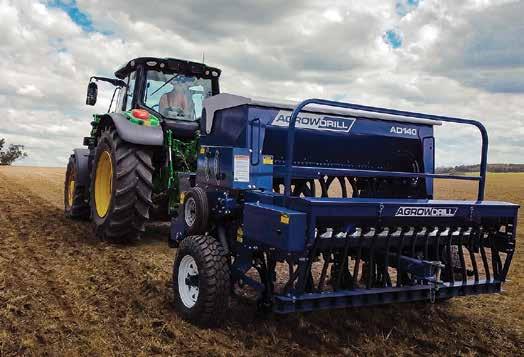
fluted roller distribution system.
The AD140, designed for small to medium operations, prioritizes durability and high clearance, minimizing trash and offering dual hoppers for seeding and fertilizing in one pass.
The AD240, a popular model, boasts simplicity, reliability and flexibility, with wheels placed inside the working width, enabling sowing across the entire machine width.
The largest model, AD730, caters to broadacre farming with high capacity and wide working widths.
Agrowdrill box drills come with various undercarriage options, such as high breakout tines, coil tines, spring tines, and double-disc units, ensuring adaptability to different soil conditions. Options like coulters, presswheels, harrows, and more can be added based on machine configuration.
To explore Agrowplow’s range of seeding equipment, including accessing machine pricing and configuration tools, or to connect with over 120 dealers nationwide, visit www.agrowplow.com.au .
John Shearer’s Mk4 Universal seeder bar is based on the company’s history of building topend, robust machines designed to handle the rigours of the Australian farming and agriculture industry.
One look at the Universal Seeder bar and you can see the strength that has been engineered into the machine. The main frame includes four rows of 100mm x 100mm mounting ranks, of which the front and rear centre section beams are 9mm for additional strength.
Working widths include 15.2m, 16.8m and 18.2m for a double fold model and 7.9m to 13.8m for a single fold model. Both versions able to fold suitably when being transported on the road. It also sits on wider wheels and tyres designed to provide better traction in soft conditions.
“The Mk4 seeder bar is like no other machine on the market,” says John Shearer operations manager Franco Perotta.
“The most notable improvement on the Mk4 seeder bar is the all-new, precision tine opener.
“Wielding an impressive 590kg of breakout force,the opener has been designed to suit any terrain needed for the everyday agricultural worker.”
Using regulated force from the main hydraulic c ram, the opening tine is designed to cultivate deeply to assist with moisture during the initial phase before the fertiliser is applied and covered. This reduces problems that may be created by the seed coming into direct contact with the fertiliser.
Seed is then placed into the furrow via a seed tube which can be adjusted to place the seed at depths varying between 6mm and 70mm before the furrow is closed by a press wheel, which
Launched in early 2020, Novag low disturbance no-till direct seed drills are making some headway into both NZ and Australia.
Carrfields Machinery Australia has sold the importation, sales, and service business for Novag direct seed drills into Australia to Guy Fordham.
Under this new arrangement, both parties are committing to a strategic collaborative relationship for the support and importation of Novag, Knuckey and Coolamon products into New Zealand, whilst Carrfields supports Guy’s new business to continue the development of Novag in Australia.
Guy has managed the Australian distribution for the last eight years and has a thorough understanding of the business from an operational perspective, as well as strong relationships with customers and suppliers.
Now distributed by Fordham Agricultural Machinery, Novag supplies a range of seed drills, manufactured in France.
This European designed and

uses a hydraulic ram to apply constant pressure – via independent pressure from the main ram. This also allows packing pressure to be altered on the fly by the operator.
One of the really innovative features of the Mk4 seeder is the unique linkage that allows the entire assembly to retain the same working angle as it follows the ground contours.
The advanced hydraulic control
system isn’t the only innovative highlight of the new Mk4 seeder, with John Shearer’s Active-Pack control system giving the operator control over the press wheel’s packing pressure.
Once the desired pressure has been selected, the Active-Pack system adjusts the hydraulic pressure on the ram controlling the press wheel, enabling smooth and even travel across varying terrain.
manufactured seed drill incorporates a low disturbance hybrid opener design, which offers farmers and contractors the ability to handle direct seeding into all conditions and residues in one pass.
The range spans from the viticulture and horticulture range –the 150 and 250 models that are compact by design, followed by the 350 (3m), the 450, which is available in (4 and 4.5m) working widths, the 650 (6m) and the 950 range that is available in either 8, 9 or 10 metres working widths.
Novag T-ForcePlus drills use the T-SlotPlus opener, an advanced and science-based tool for successful no-tillage cropping systems.
The T-SlotPlus opener creates minimal surface-soil disturbance while creating an inverted T-shaped slot.
Seed and fertilizer can be placed separately on the adjacent horizontal shelves of the inverted T.
Novag’s IntelliForcePlus electro-hydraulic system automatically regulates opener

downforce, responding rapidly to changing soil conditions to maintain consistent and accurate seeding depth. Each opener can apply from 100 kg to 500 kg of downforce.
One of the founding principles of no-tillage farming (and indeed nature itself!) is to always have the soil surface covered with growing or decaying vegetation. The soil is protected from moisture loss and erosion, water infiltrates more effectively, soil organic matter content increases from earthworm and microbial activity, soil structure and natural drainage improves, and weeds are supressed.
Novag openers manage dense residues very well thanks to the blade/disc combination.
The seed placement by the blades, on the side of the slot, prevents hair pinning problems which are otherwise common with disc drills.
All machines incorporate the T-ForcePlus opener and IntelliForcePlus automatic downforce system and can be supplied to provide up to four different products plus liquid if required.
For more information on this product range, contact: https:// fordhamag.com.au or Novag; https://novagsas.com/.
Serafin Machinery’s superior, Australian designed and manufactured Serafin Ultisow single disc seeders are a result of thorough testing and input from farmers and contractors. Their experienced design and manufacturing team took all feedback on-board and improved the strength, reliability and accuracy of seed placement to enhance the Ultisow range.
The Ultisow has proven to be the right balance for all conditions as the row unit is extremely versatile, requiring little to no maintenance and it has a robust frame that can withstand Australia’s conditions. Years of continuous research and development into improving the Serafin row unit have allowed the operator to achieve superior seed placement resulting in the best yields time and time again. The Serafin SM row units are performing with flying colours. Reduced maintenance means less down time on the units, being able to get more hectares out of them before needing to spend more money and farmers are more confident in the unit. The latest option to be included to the Serafin SM row unit

is the Serafin Ultiforce which is a low-maintenance hydraulic downforce pressure system with it’s own cylinder, replacing a traditional spring. The single-acting hydraulic ram option allows for more consistent down pressure, reduced row-unit vibration and increased durability, improving seed placement. Many customers are upgrading from the traditional spring to the Ultiforce cylinder and are happy with the results.
The Ultiforce isn’t the only improvement to hit the market. Serafin Machinery believes it has designed the ultimate new disc seed bar model based on feedback from its long-term customers.
Serafin Machinery designers have been working on the Forward Fold single disc seed bar model since early 2021. Record planting seasons started to squeeze the planting window even tighter as growers added more ground to their farm operations.
There are in fact three working width options in the Ultisow Forward Fold range–choose from 18m or 24m (60ft and 80ft) working widths and the soon to be released S12 Forward Fold Design (40ft/12m).
The Ultisow S12 Forward Fold design incorporates two ranks to give this model the ability to sow at 250mm (10-inch) row spacings on two ranks, or at 375mm (15-inches) on one rank while all the time achieving a consistent and uninterrupted trash flow.
Keeping with the program, Serafin designers have made sure it can fold to 3.7m width and 4.2m height to get the tick of approval for transport that farmers have been asking for moving forward.
And apart from the narrow
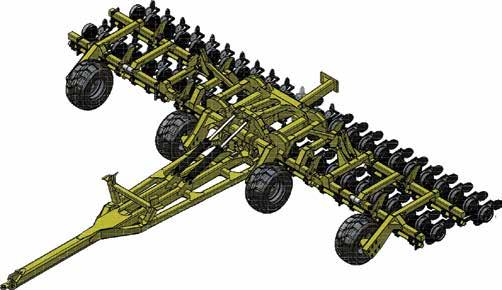


transport width of 3.7m, the Forward Fold can also lift up on its wheels using hydraulics much like Serafin’s other popular model the Serafin Hi-Lift.
And with the attributes of a Serafin Hi-lift model, the special lift and fold design brings the Forward Fold row unit up to chest height, making it easy to make any adjustments while in the paddock, if required.
Serafin designers have also made sure these seed bars are built tough.
The main frame has a full powder-coat finish, and the hydraulic lift and fold mechanism is made to last and give easy access and lift without having to crawl around under the frame.
Fitted as standard are six large heavy-duty flotation tyres, and operators will appreciate the electric over hydraulic control of the row unit down pressure, all controlled from inside the cab.
Serafin Machinery are proud
of their Ultisow design and will continue to make their machines as productive and low-maintenance as possible with the help of their experienced manufacturing team, while working with farmers and contractors to modify the Ultisow to suit their farming operations. While we wait for the official release of the S12 Forward Fold model, scan the QR code below to check out our current Forward Fold models – perfect for farmers who have CTF operations requiring multiples of 12m.

› It’s available free of charge to readers who qualify under the publisher’s criteria and who supply proof of occupation.
› All the latest news, views and information from the industry.
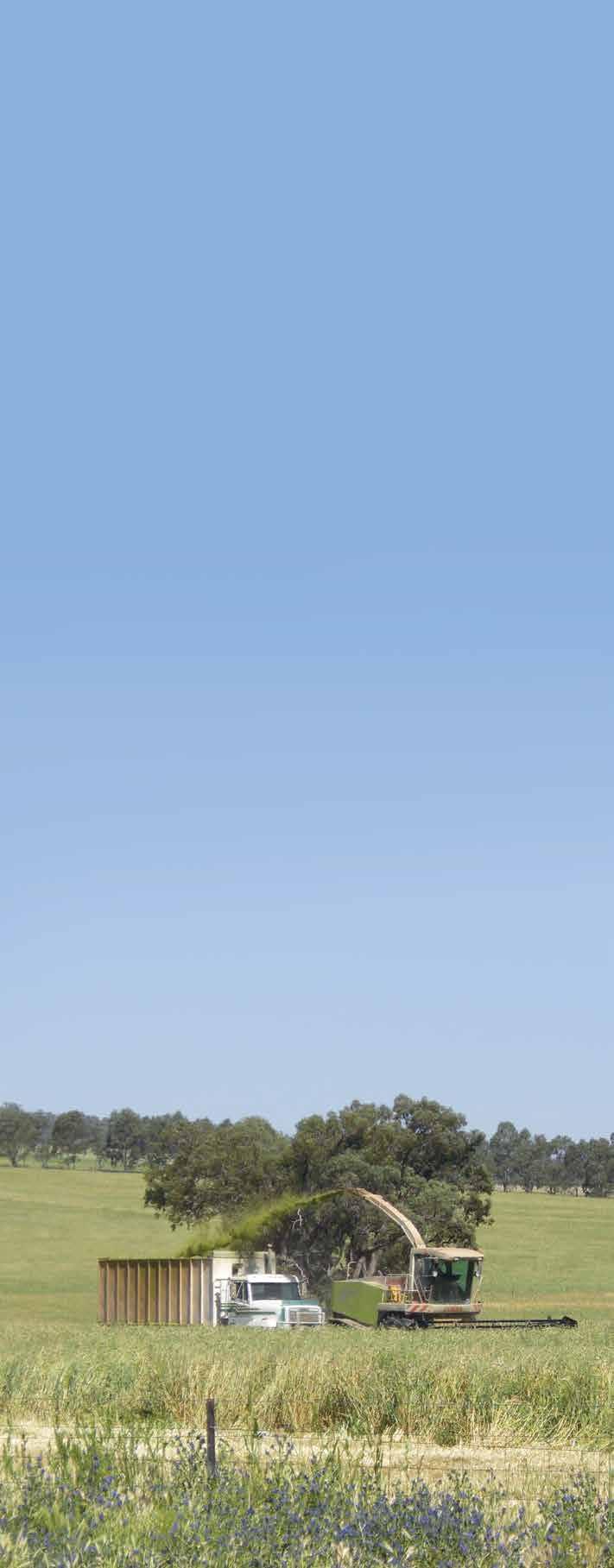
If you are not a registered reader but would like to receive a regular bi-monthly copy, please fill in the details below of your contracting or farming business and post this form to us.
Alternatively, you can fill in the subscription form on our website: www.agcontractormag.com
Australian AgContractor is available free of charge to readers who qualify under the publisher’s criteria and who supply proof of occupation (ie. printed letterhead, business card, invoice etc.) and to others upon payment of the $50.00 annual Australian Subscription (Rest of the World: $65.40 AUD).
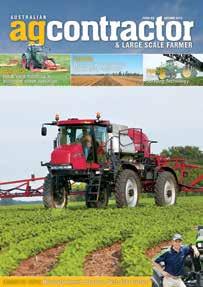


› In-depth profiles on contractors and farmers from all across Australia.
› Six issues per year, delivered direct to your door.
› Subscriptions from as low as $50.00 annually to non-industry subscribers.
Please email admin@agrimedia.co.nz or phone +64 3 329 6555 to arrange payment if you are a non-industry subscriber.
Name:
Business/Farm Name:
Postal Address:
Postcode:
Country:
Phone:
Email:
coNTracTor
Main contracting services offered:
Criteria: Broadacre - over 1000ha and/or Sheep or Beef - over 12,000 stock units and/or Dairy - milk over 400 cows (owner or sharemilker)
Total farm ha: No. of dairy cows: No. of beef cattle: No. of sheep: Area in arable crop:
Please sign here if you wish to receive a regular copy of this publication and send the form, together with proof of occupation or cheque to: aML, Po Box 37151, christchurch 8245, New Zealand.
Signature:
Date:
KUBOTA AUSTRALIA IS SETTING THE INDUSTRY BENCHMARK WITH THE LAUNCH OF THE NEW RTV-X1130 UTILITY VEHICLE, DELIVERING HIGH PERFORMANCE, DURABILITY AND RELIABILITY.
Using the proven extended chassis of Kubota’s 4-seater RTV-X1140 model, the RTV-X1130 builds on the highly regarded Kubota diesel RTV range.
The new model offers the added benefit of a 6-foot-long cargo tray and includes the range’s trusted features, such as the Kubota D1105 engine, dynamic braking, VHT smooth transmission, enclosed wet brakes, hydraulic tipping tray, and hydraulic power steering.
Kubota Australia Marketing Manager Mark Basile said the improved RTV-X1130 is top of the range for utility vehicles.
“The more space for cargo makes it one of the most versatile RTVs on the market. Whether you’re in construction, working for a municipality, a farmer or just needing to transport loads of material from A to B, the RTV-X1130 is designed to outwork.
“The RTV-X1130 tray length has been extended for transporting longer items and the cargo load capacity has increased to 550kg. The bed volume has also increased to 0.74m3 giving you more capacity to get the job
done,” Mark said.
“The Pro-Konvert cargo bed delivers a tray conversion which can be done quickly and easily. Both side panels and the tailgate are foldable to give you better access to the items in the cargo bed while on the job. These can also be completely removed to reconfigure your tray to a flatbed within minutes.”
As a work-orientated machine, the spray-on bed liner has been used to prevent scratches to the tray.
“The new cargo bed also has integrated stake pockets which allow you to section off areas in the cargo bed using pocket dividers. If you’re looking for increased side panel height, the heavy-duty side gates feature integrated stake/divider pockets for further material handling,” Mark said.
The standard hydraulic dump bed takes the hassle out of moving heavy materials from the cargo bed such as sand, gravel or turf.
“Materials that take significant physical strength and time to unload can be dumped with little effort in seconds,” Mark said.

“The independent suspension on all four wheels and Kubota’s variable hydraulic transmission provide exceptional performance through smooth throttle control, great traction and manoeuvrability, regardless of the terrain or load.”
The RTV-X multi-disc wet brakes provide long brake life, and the dynamic braking delivers additional breaking power and greater driving control including when travelling down long declines.
“The Series also features a high-rigidity steel frame which isolates operators from noise, vibrations and harshness giving you the extra sense of security. With structural strength that
few in the industry can match, this durable frame can endure years of heavy loads and rough terrain.”
There are a range of new cargo box accessories such as a tailgate extender, storage boxes, cargo bed winch and LED light for inside the cargo tray that represent capability reimagined.
“If you’re looking for a vehicle to match whatever the day throws at you, the RTV-X1130 is ready to tackle anything. When it comes to cargo, nobody carries it better.”
Deliveries of the RTV-X1130 will be available from March 2024 and the RRP is $35,161 (including GST). Contact your local dealer to find out more.

THE POWER AND CAPACITY OF JOHN DEERE’S X-SERIES COMBINE HARVESTERS CAN NOW BE COMPLEMENTED BY THE ADVANCED WEED CONTROL CAPABILITY OF REDEKOP’S SEED CONTROL UNIT (SCU) WHICH DESTROYS HARVESTABLE WEED SEEDS IN A SINGLE PASS.
The Redekop SCU mounts to the combine chopper and injects processed chaff directly into the residue stream for excellent distribution over the entire cutting width. In doing so, it destroys weed seed, helping to manage weed resistance for the next seasons.
SCU for X-Series will be available from 1 February, following three years of testing on X-Series working in Canada, Australia and Germany, where it performed with flying colours.
John Deere Production System Manager, Ben Kelly, said all the benefits already enjoyed by customers with SCUs on S-Series combine harvesters could now be enjoyed by the owners and operators of X-Series.
“The SCU is already a proven performer on the S-Series and we are excited to have worked collaboratively with the team at Redekop to adapt the technology to be suited to the power and capacity of the bigger machines,” Ben said.
“This will also open the door to the X9 being an option for more farmers, knowing they can fit this highly effective weed control system, further allowing them to grow the efficiency of their small grain and cereal cropping operations.”
Redekop’s Trevor Thiessen said the trials of the past three years clearly demonstrated the combined John Deere and Redekop design team had created an iteration of SCU that could handle the additional volume presented by the X-Series, without compromising harvester throughput.
“The X9 has significantly more capacity, including cleaning shoe capacity, than the John Deere S-Series, so we had to make sure that the mills taking the material off the back of the harvester could handle that,” Trevor explained.
“We tested the SCU in Australia and Canada, but we were most concerned with the amount of straw and material it would encounter in European conditions. Being able to prove the X9 SCU in German wheat crops that were pushing eight to nine tonnes per hectare, and some barley running at elevenand-a-half tonnes per hectare, gave us confidence the unit could perform anywhere.”

Redekop worked closely with John Deere engineering departments to fine tune and adapt air flow, shoe pressure, load limits on the drive line and other components in the new iteration of the SCU.
“To ensure the technologies work together, John Deere provided us with a pre-production X9, so we did our fit-up, fabrication and design work with that,” Trevor said.
“We had drawings for the back end of the combine that we could modify in the CAD system before we tried the physical prototypes, so that made it easier to develop a solution that integrates seamlessly with the X-Series.”
The Redekop SCU, mounted behind the cleaning shoe of the X-Series and fully integrated with the machine, is designed to work in all crop conditions with one set of mills, negating the need to swap mills in response to crop or harvest conditions.
The reversible mills can destroy up to 98% of harvestable seeds before the material is directed back to the residue stream, mixed
REDEKOP’S SEED CONTROL UNIT DESTROYS WEED SEEDS IN A SINGLE PASS, ENHANCING HARVEST EFFICIENCY.
with straw and spread evenly over the entire cutting width, to ensure minimal weed pressure and better crop establishment in subsequent seasons.
The SCU is fully integrated with the G5PLUS CommandCenter™ and can be easily engaged or disengaged as required.
“The integration with CommandCenter was flawless, there were just some tweaks to the software to make it all work and we have a great relationship with the John Deere engineering departments making it easy,” Trevor said.
“In Canadian trials, farmer co-operators were very pleased with the ability of the X9 SCU to handle crops when running side by side with X9s that weren’t fitted with the unit.”
To find out more contact your local John Deere dealer.

THE LIMITED RELEASE KOREANMADE TYM T2900 TRACTOR IS A GAME CHANGER WITH PLENTY OF TORQUE AT LOW RPM AND AUTO THROTTLE CONTROL. IN STOCK NOW AT TYM DEALERS, THE SPECIAL LAUNCH PACKAGE INCLUDES A QUICK DETACH LOADER WITH 4-IN-1 BUCKET.
Gary Surman, Inlon’s Sales & Marketing Manager, talks about torque. “The TYM T2900 1,175cc turbo-charged diesel engine delivers 28hp at just 2,600rpm, taking performance and efficiency to the next level. The low revving TYM engine provides better operator comfort.
“The two range HST transmission has side-by-side pedals for easy forward and reverse changes. Auto throttle links the HST pedals to the engine throttle to synchronise the tractor’s speed and engine rpm. This simplifies operation, helps increase productivity and reduces fuel consumption.
“Extra driver leg room and cruise control make for an easier day in the field, while the two-post folding ROPS helps navigate low clearance spaces.”
The tractor-only weight of 841kg with its heavy front axle and long 1,502mm wheelbase is perfect for loader work and heavy jobs where you need extra stability.
The T2900’s large industrial front and rear tyres give extra traction and handle heavy loads when using the front-end loader operations.
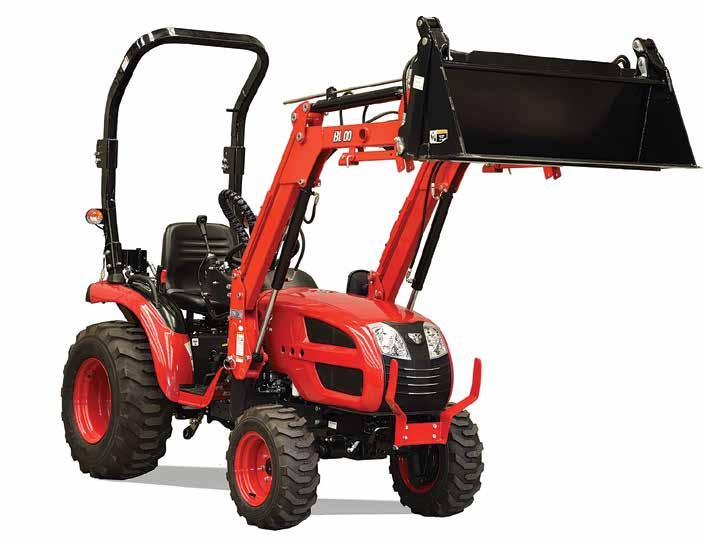

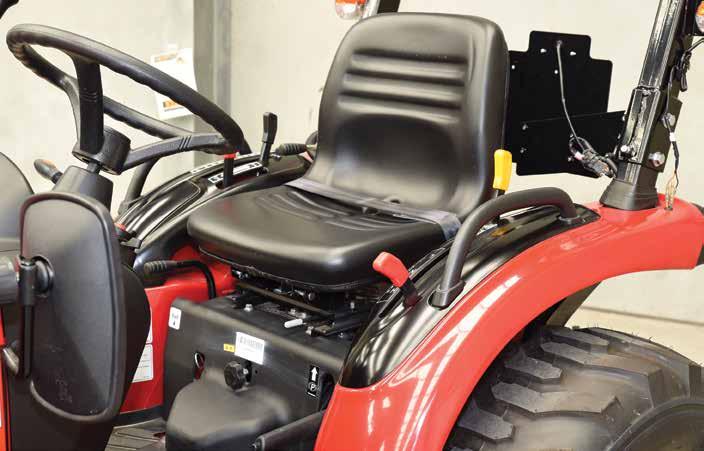
The T2900 body panels are all made of steel with easy access under the bonnet for servicing.
Distributed Australia-wide by Inlon, the limited release launch package includes a quick detach loader, 4-in-1 bucket, bump guard and loader parking stands for $27,990 including GST.
TYM tractors are renowned for high quality, well-designed products, backed by heavy research and development investment.
For more information, please visit www.tym.ag/930 or call Inlon on 1800 945 090.
JOHN SHEARER HAS ENGINEERED ITS MK4 UNIVERSAL SEEDER BAR WITH STRENGTH AND DURABILITY IN MIND TO ENSURE IT’S CAPABLE OF HANDLING THE UNIQUE CONDITIONS POSED BY THE AUSTRALIAN FARMING AND AGRICULTURE SECTOR.
Available in working widths of 15.2m, 16.8m and 18.2m for a double fold model and 7.9m to 13.8m for a single fold model, the Mk4 seeder bar is based on a main frame which includes four rows of 100mm x 100mm mounting ranks, with additional strength provided by 9mm centre section beams front and rear.
The new seeder bar features a new precision tine opener that offers breakout force of 590kg, utilising regulated force from the machine’s main hydraulic ram.
To reduce issues that may be created by the

seed coming into direct contact with the fertiliser, the opening tine is designed to cultivate deeply to assist with moisture during the initial phase before the fertiliser is applied and covered.
Before the furrow is closed by a press wheel, seed is placed into the furrow via a seed tube which can be adjusted to place the seed at depths varying between 6mm and 70mm.
Using independent pressure from the main ram, the press wheel can apply constant pressure through a hydraulic ram, which allows the operator to alter packing pressure on the fly.
The John Shearer team has also engineered a unique linkage into the Mk4 seeder, which
allows the entire assembly to retain the same working angle as it follows the ground contours.
The advanced hydraulic control system isn’t the only innovative highlight of the new Mk4 seeder, with John Shearer’s Active-Pack control system giving the operator control over the press wheel’s packing pressure.
Once the desired pressure has been selected, the Active-Pack system adjusts the hydraulic pressure on the ram controlling the press wheel,
Both the single fold and double fold versions are able to fold suitably when being transported on the road while wider wheels and tyres are designed to provide better traction in soft conditions.

B&B CELEBRATE 34 YEARS IN BUSINESS THIS YEAR, PROUDLY SUPPORTING AUSTRALIA’S AGRICULTURAL SECTOR. IT BEGAN IMPORTING KEMPER FRONTS IN JANUARY 2002, AND IT HAS SOLD AND SERVICED KEMPER EQUIPMENT FOR ALL FORAGE HARVESTER MANUFACTURES EVER SINCE.
B&B are located in Toowoomba, an ideal location to link Northern and Southern Australia. Their location means they can supply parts overnight or at most, two days to most agricultural regions in Australia.
B&B’s service to customers is first class, from initial enquiry though the sales cycle, and it continues thereafter with outstanding after sales service and support.
Another advantage B&B Machinery has is that it is not governed by a single self-propelled harvester manufacturer. It can supply Kemper fronts to suit all brands.
Kemper has been the market leader in row-independent rotary headers for self-propelled forage harvesters for 40 years. Nearly every second forage harvester in the world works with a Kemper harvesting head. Professional
customers prefer Kemper fronts because of their versatility, operational reliability and second to none back up service.
Following the success of the PLUS Series, Kemper has released the new 300 and 400 PRO Series corn fronts for the 2024 corn season. Cutting widths remain the same as the previous PLUS Series at 6m (8-row), 7.5m (10-row) and 9m (12-row).
Kemper’s aim with the new PRO Series is better durability, optimised plant intake and minimizing plant losses creating the best performance even under the most difficult conditions to give them a higher annual throughput than competitor fronts, have a longer service life and require minimal maintenance during the season.
Kemper has taken these concepts into account and offer

longer-lasting, heavy-duty components for all critical wear parts on the new PRO Series. This especially applies to the saw blades, skid shoes, crop divider

pointers and numerous areas of the feeding drums.
Crop losses in the field are the biggest pain point for every farmer.
All models on the new PRO Series from Kemper now have a patented tooth shape ‘claw’ on the gathering drum that securely grips and holds the plants and guides them straight into the feed channel. This new drum design latches every single plant even on headlands.
Plant transfer in the cross-feed channel has also been improved. Bottlenecks have been eliminated on the 400 Series by creating a crop channel that becomes increasingly wider towards the centre of the front. Even big crop loads are transported safely, leading to increased throughput. The new channel design also makes reversing easier.
If the maize is planted in row spacings other than 75cm (30”) or when harvesting on hillsides,

adjustable outer ends of the push bar now allow adaptation to these conditions. When harvesting crops that tend to hang over the push bar, it can be easily removed on 400 PRO models. In down crop it is important that the pointers of the header go under the lodged maize plants. The new low designed gathering drum on the 400 PRO Series reduces the risk of plants being pushed forwards and left un-cut or accumulating on top of the drum which can lead to blockages. This is a big relief for the operator as it results in fewer stops and reduces the need for reversing.
The 300 PRO Series now has a bolt on divider point which can easily be removed in down crop allowing the drum to collect the crop directly.
To ensure that important components of the SPFH, like knives, shear bar, kernel processor, etc, are worn out evenly, the crop flow needs to be equally distributed over the full width of the feeder house. This starts with corn front.
The middle section where the two sides of the machine meet have been redesigned resulting in better lateral distribution of the crop across the width of the feeder house.
This leads to a higher lifetime of all components due to more consistent wear. This also results in higher efficiency and better performance from the forage harvester.
Cleaning the header and specif-
ically the inside of the big gatherer drums has now been made easier. The complete top of the gathering drum on the 400 PRO Series can be removed with just a few bolts to remove debris.
Last but not least the new 400 PRO Series can now adjust the angle of the front at the headstock ‘levelling’ the front for different crop conditions no matter the tyre size on the SPFH.
The new 300 PRO and 400 PRO harvesting fronts offer customers a completely new harvesting experience with the all-new intake and crop flow. This makes life easier for the driver, especially in challenging harvesting conditions such as down crop.
Kemper headers are well known for their high resale value if well maintained and hold their value even after years of use. Kemper produces these new harvesting heads for all well-known SPFH brands. The new PRO Series can be ordered up until mid-May for November 2024 delivery in Australia.
Kemper has now produced the C3003 grass pick-up front to suit the Claas Jaguar forage harvester range for a number of years.
Not resting on their laurels, Kemper have continued to develop their pick-up to stay ahead of the competition. The Class machine is fitted with the quick coupler for easy coupling to the harvester and all models are standard with chain lubrication via automatically lubricated felt wipers.
An even crop flow is supplied by
the floating single compression roller, adjustable rake tines and staggered pick-up tines. Couple this with the huge 560mm diameter, patented flighting feed auger with the Kemper C3003 ensures an even crop flow into the harvester. Hydraulically folding, 360 degree pivoting pneumatic gauge wheels ensure consistent pick-up ground clearance in the most unforgiving ground conditions.
B&B Machinery currently have the durable C3003 in stock ready for immediate delivery.
Having sold and serviced the Kemper brand for more than two decades B&B also offer a direct disc front option to forage harvester owners.
Dominoni started producing corn heads for combine harvesters in the small village of Crema, Italy more than 50 years ago. In recent times they have branched out to sunflower and soybean attachments for combine harvesters and, more importantly for forager owners, they have also produced direct disc fronts in a variety of sizes (though 6.1m and 7.6m are the most commonly sold sizes here in Australia) to suit most brands of forage harvesters including Claas, JD, Krone and NH.
What makes them so good? Kris Black, owner of B&B Machinery in Toowoomba QLD says, “They are simple, reliable and strong. A massive chain-driven feed auger, pivoting headstock, high quality Walterscheid drive shafts, heavy duty Comer gearboxes and the

tried-and-true Kuhn disc cutter bar set this machine apart from its competitors’ complex and costly machines.
“Couple this with a competitive price and B&B Machinery’s well known after sales support you will never look genuine again!” B&B Machinery has invested heavily in machine specific spare parts not available on the shelf locally to ensure machines sold in Australia are supported through busy harvest periods. Machine orders take three to four months to deliver ex-factory from date of order so be sure to think ahead as B&B stocks are limited.
For more information on Kemper and Dominoni please contact B&B Machinery on 0746 302 000 or email krisb@bbmachinery.com.au.

THE TEGOSEM HOPPER MADE BY PÖTTINGER IS AVAILABLE AS AN OPTION FOR A WIDE RANGE OF MACHINES.
With the Tegosem, soil cultivation, seeding and application of different seed and fertiliser materials can be carried out in a single pass. This saves time and money. The flexible hopper can be combined with both linkage mounted and trailed machines.
Thanks to the two different metering shafts, grass seed or similar companion crop seeds can be sown in addition to small and large-seed cover crops. The Tegosem can be combined with a range of machines – whether tillage implements or seed drills –to cover a broad spectrum of applications
Used in combination with a Pöttinger seed drill, the Tegosem enables an additional component to be applied to the surface. This means that the sowing of companion crops or cover crops can be carried out on the same pass to conserve the soil. Small seeds are very good for adding to cover crop mixtures, but require placement on or near the surface for optimum germination.
The Tegosem enables material to be deposited on top, while placing the majority of the mixture deeper down. As a result, several components can be included successfully in the cover crop mixture.
Soil fertility is also given a positive boost, because mixtures with at least eight different types of seed are proven to promote soil life and increase the biodiversity of microorganisms.

The Terrasem seed drill with Tegosem sowing unit enables three components to be applied simultaneously.
This means that companion crops can be sown with the main crop. In addition, a component from the Tegosem can be fed directly into the coulter. At the same time, the Fertilizer-Pro coulters are used to deposit starter fertiliser.
The Terria, Synkro, Terradisc, Lion and Fox tillage and seedbed preparation implements are also available with the Tegosem.
A major advantage here is being able to combine tillage with sowing a cover crop, because suitable weather windows are often short and every second counts. Precious time is saved by eliminating the hour pass.
Especially in terms of the Common Agricultural Policy, where fallow land over the winter can now be easily avoided. The seed is deposited by distributor plates in front of the rear roller, which immediately ensures optimum consolidation and restores the capillary effect. That way, everything is prepared for optimum seed emergence.
A cover crop or companion crop can also
be sown using the Tegosem as part of a crop care measure.
Companion crops are particularly suitable for root crops with wide row spacing to protect against erosion and make the soil easier to drive over in the autumn. They have the advantage of stabilising the soil with their roots and improving drainage.
The Rotocare rotary hoe breaks up the soil crust while the seed is added directly behind the raised flow of soil. This means that the seed material or granules are then covered with soil. In addition, moving the soil causes the mineralization of nutrients, which benefit the companion crop and the main crop.
The flexible Tegosem hopper is the perfect partner for tillage and seedbed preparation implements. With this combination, companion crops, cover crops and fertiliser can be deposited in a single pass to conserve resources. This process makes a contribution towards preserving the fertility of soil and forms the basis for sustainable farming.




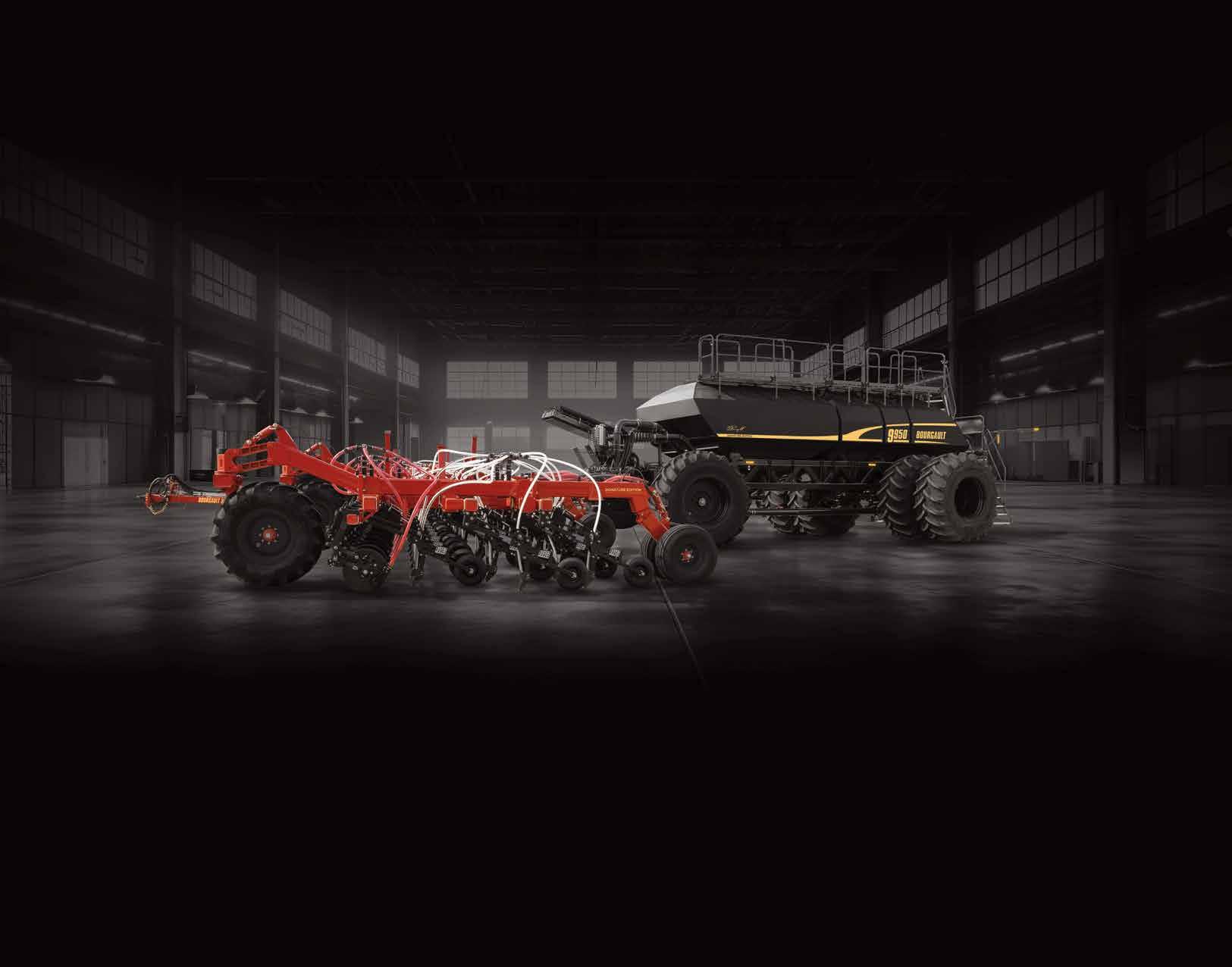



AMAZONE: standing for innovation.
Established in Germany in 1883, AMAZONE is a global leader in fertiliser spreading, spraying, cultivation and seeding technology.
Developing and producing innovative agricultural technology with industry-leading standards of quality that incorporate the latest development in technology and modern, economical arable farming systems.
Discover the difference today.



